We’ve made it to Antigua and are getting Vega ready to cross the north Atlantic to the Azores. Here’s a look back at our time in St Helena.
Wednesday 8th to Friday 17th March 2023
All I knew about St Helena was that it is somewhere in the South Atlantic and is where Napoleon Bonaparte was exiled. It is also located directly on the route from Cape Town to the Caribbean and so ideally situated for a stop to break our journey. After 15 days at sea we would be glad to walk on land that didn’t move under our feet (we hoped), rest for a while, get wifi, reprovision with fruit and vegetables, fill our tanks with fresh water and fix whatever had gone wrong on the trip.
The morning after our arrival at St Helena, Port Control called us up on VHF radio to advise on check-in procedures. It is not permitted to take your own dinghy ashore as there is a dangerous swell and no suitable space to tie up at the harbour. Instead a small ferry boat runs half hourly during the day carrying local fishermen and yachties to and from their boats. A call on channel 16 and the St Helena ferry will pull up alongside your yacht and you step aboard trying to time it so you don’t end up in the sea. Even more hair raising is getting off the ferry at the harbour side, which involves grabbing a dangling rope when the ferry pulls up alongside the dock and hauling yourself ashore as the ferry bobs up in the swell.
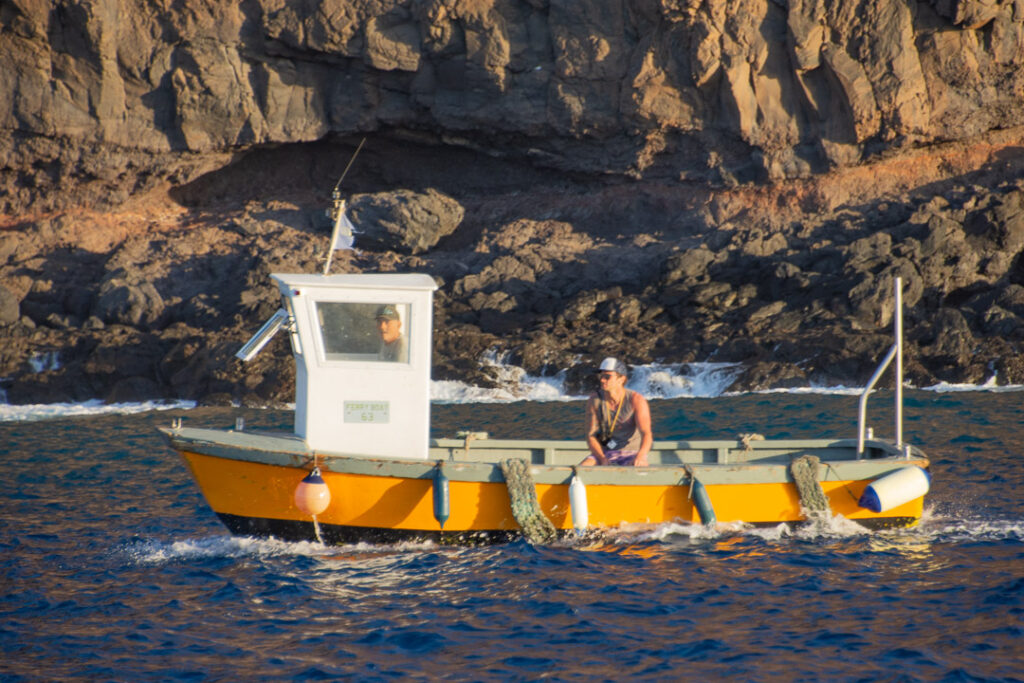
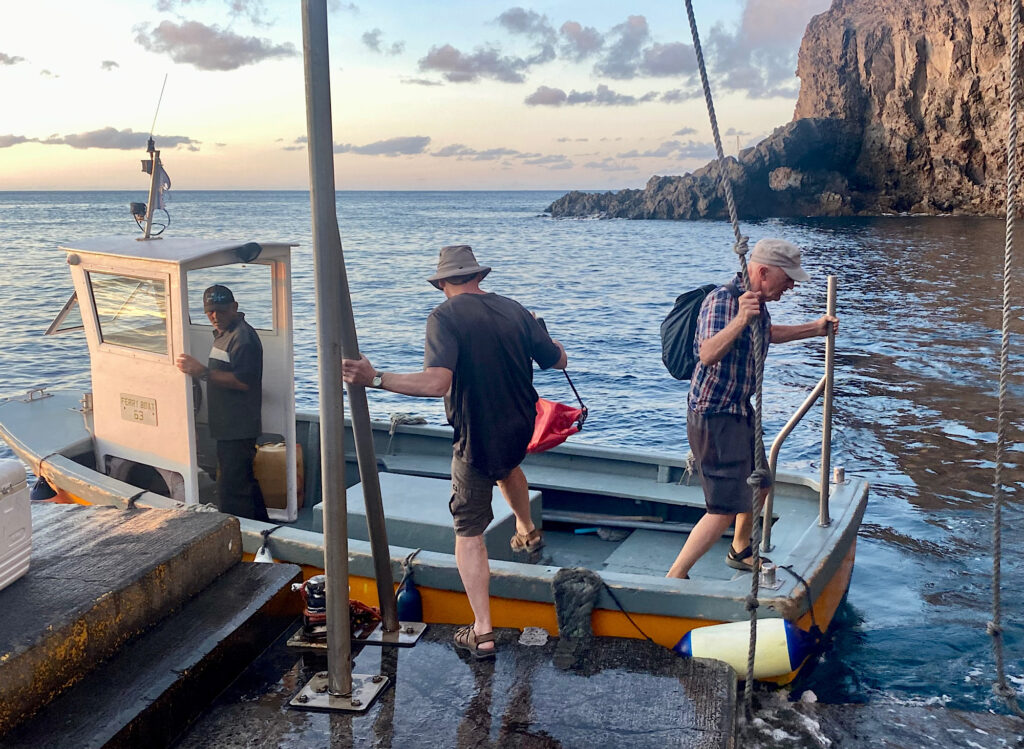
Once ashore we received a friendly welcome at Customs, Immigration and Port Authority as we visited the three departments in turn, filling in various forms, paying our £20 pp visitors’ fee and having our passports stamped. Our next stop was Anne’s Place, an open air restaurant and popular yachtie hangout where we drank coffee, ate toasties and, importantly, bought wifi time to check emails and WhatsApp messages and video-call family – most welcome after two weeks of wifi deprivation. A further priority was a visit to the tourist information office to find out about the various island activities.
St Helena is a volcanic island which was uninhabited until 1502 when it was discovered by the Portuguese who realised it would make a good staging post for reprovisioning their ships en route between Europe and the East Indies. They kept very quiet about it for some eighty years until the English stumbled across it in 1588 and took possession. It is now a British Overseas Territory, along with Ascension Island and the Falklands in the South Atlantic. Ever since it erupted from the sea 13 million years ago until its discovery in the 16th century it was totally isolated and today has 500 native species of flora and fauna found nowhere else on earth including, to Hugh’s horror, 22 types of endemic spider one of which is the Napoleon Jumping Spider. There were no native mammals and many of the original endemic species have been lost since man arrived, bringing rats, cats and goats and widespread deforestation and habitat destruction.
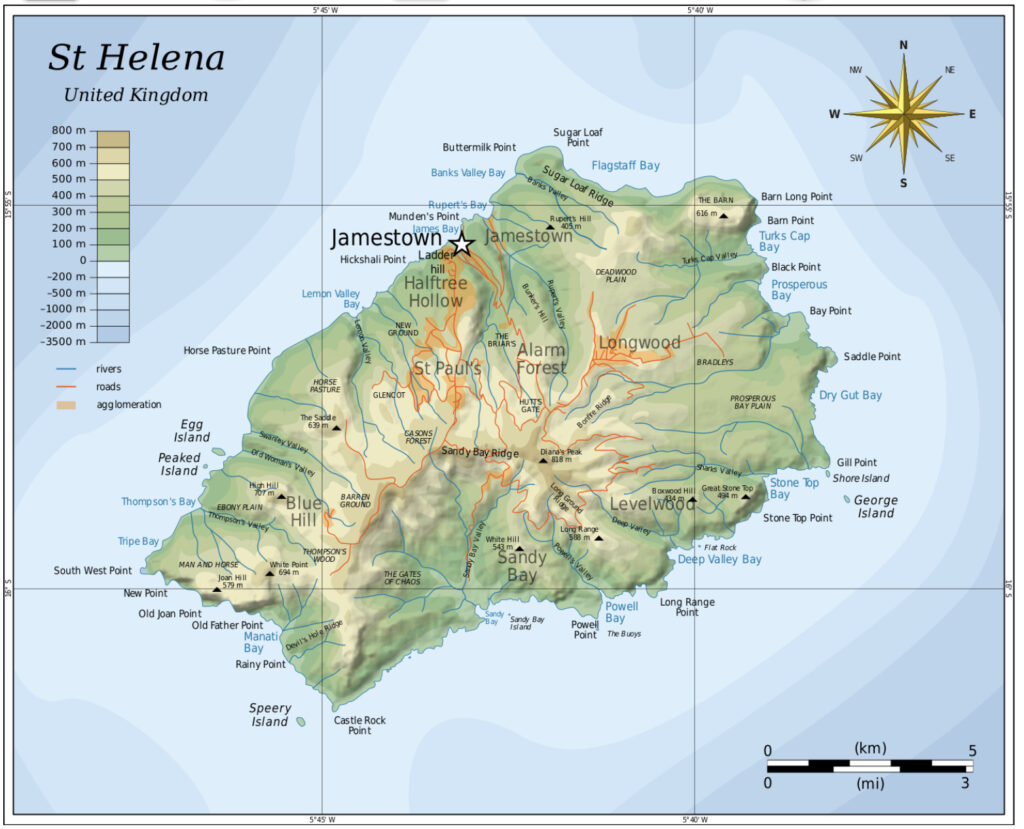
The main town on the island, Jamestown (population 625), nestles in a long valley leading down to the sea with steep bare volcanic slopes rising on either side. It appears a cross between an English market town and a Cornish fishing village, with one main street lined by Georgian houses, a castle, church, museum, library and two hotels. Further along are a number of grocery and hardware shops, the market, two hairdressers, a couple of pubs and the video rental store and beyond here, up Napoleon Street, terraces of painted houses. Walking along the street almost everyone you pass says hello and everyone seemed to know everyone else, greeting each other warmly and stopping for a chat.
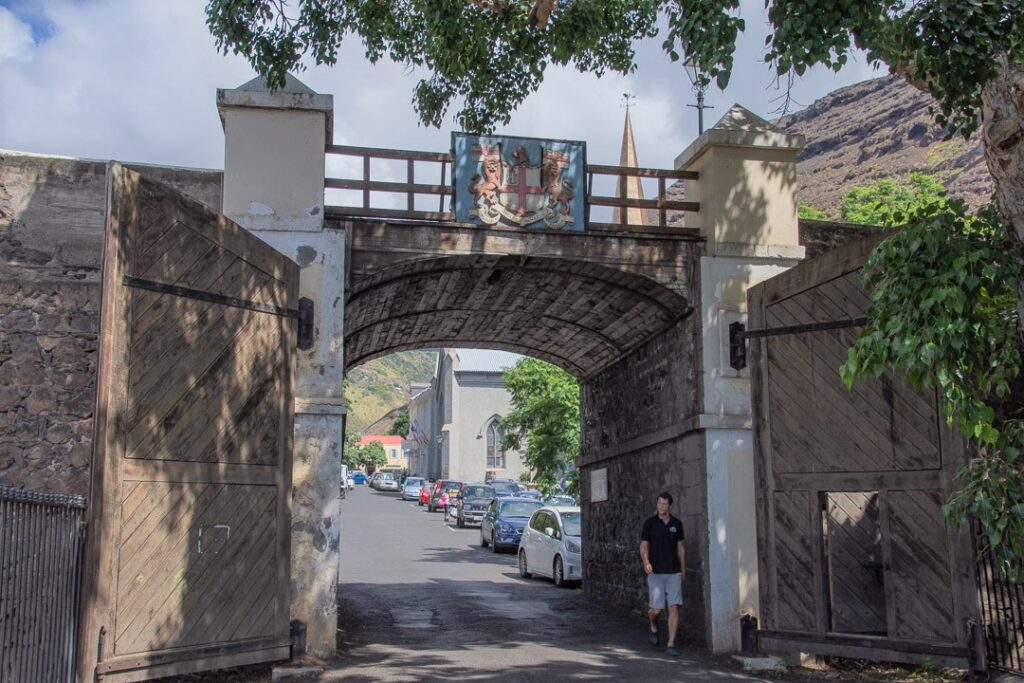
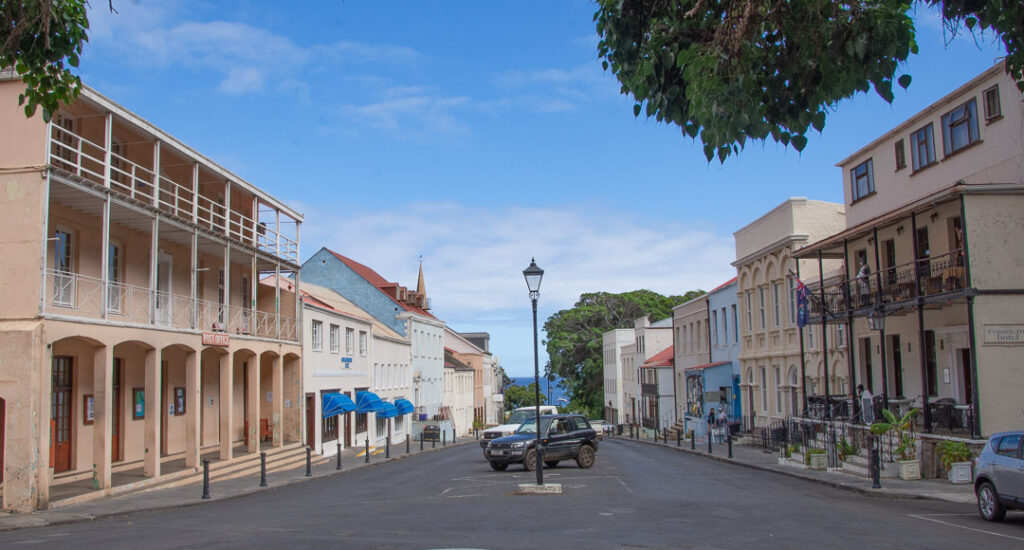
Rising above the town is Jacob’s Ladder, a set of 699 steps which lead up to the top of the cliff. The steps were completed in 1829 with a tramway running beside them which enabled ammunition and supplies to be carried to High Knoll Fort above. Every year there is a race up and down the steps, the record being just under three minutes to the top. We were rather relieved that the steps were closed for repair and we didn’t have to demonstrate our complete lack of fitness.
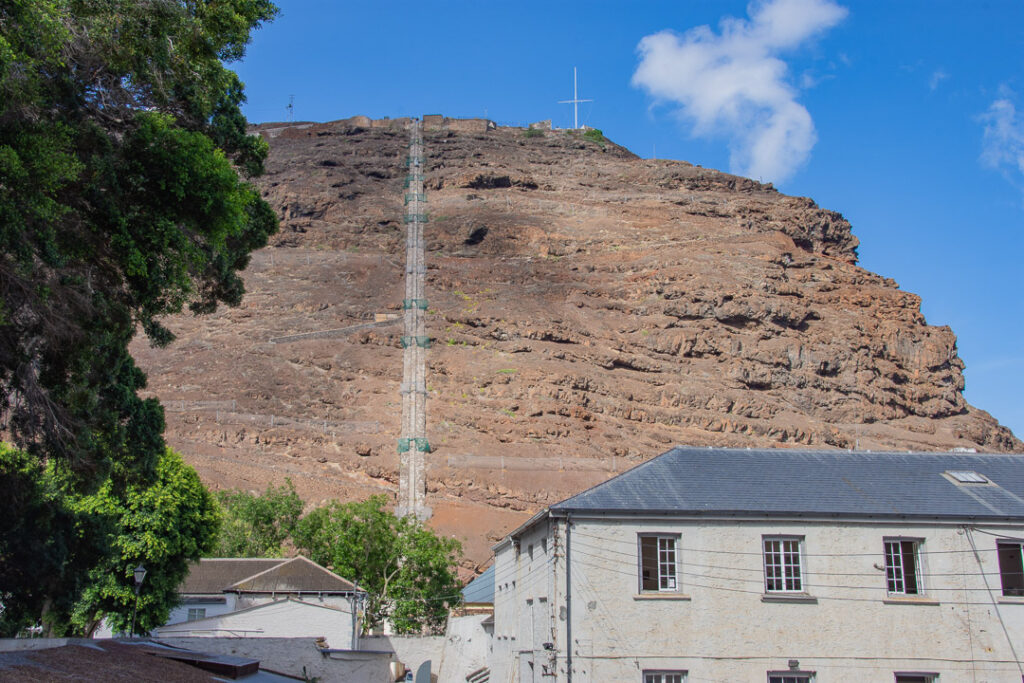
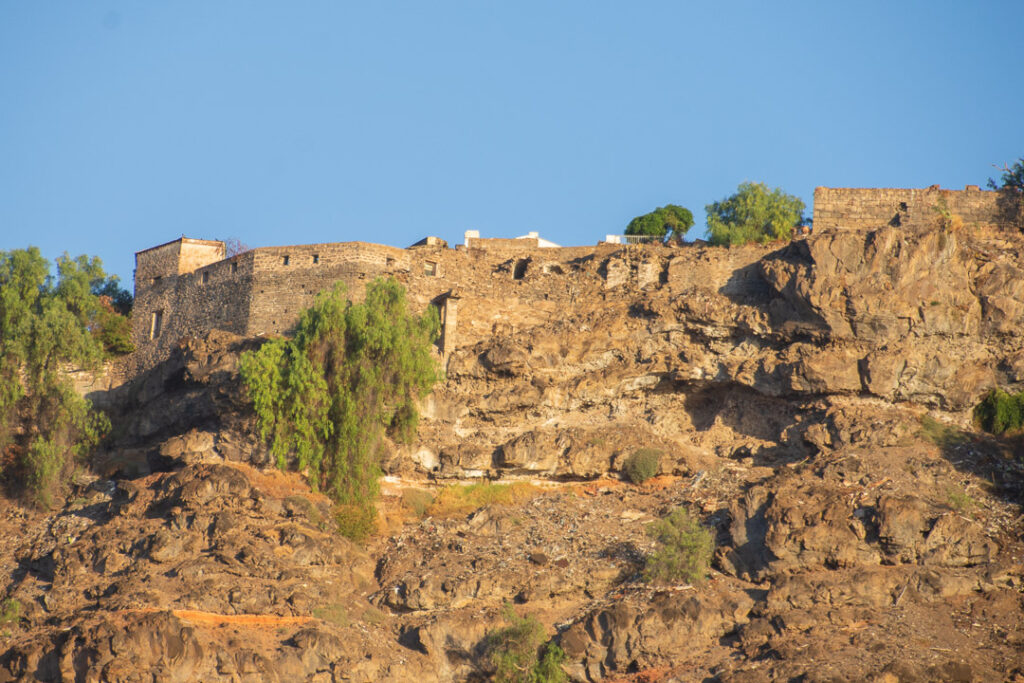
The people who live here are known as Saints and are a racial mix of the people who have settled on the island over the centuries, mainly from Europe (mostly planters, government employees and ex-soldiers), Chinese (itinerant workers from about 1810) and slaves (from Africa and Asia). The slave trade was banned in the U.K. in 1807 and the island later used as a base for naval ships to intercept slave ships from Africa en route to Brazil (many of the liberated captives then being sent on to the West Indies as indentured labourers).
The Saints had held British citizenship since 1673 until 1983 when Mrs Thatcher stripped them of their right to a British passport through the British Nationality Act, designed to stop an influx of immigrants before the handover of Hong Kong to China. Since the Falkland Islanders had been allowed to keep theirs, the Saints campaigned hard against the decision and British citizenship was eventually returned to them in 2002 on the 500th anniversary of the discovery of the island.
It is, of course, where Napoleon Bonaparte was exiled in 1815 after his defeat at Waterloo and until his death in 1821. Other visitors over the centuries have included Edmond Halley (1677), Captain James Cook (1771), Charles Darwin (1836), Joshua Slocum (1898) and Prince Andrew (1984) who rather regrettably has the secondary school here named after him.
That first evening ashore there was a BBQ at the yacht club. During Covid several yachts had been stranded at St Helena as countries closed their borders. During this time they renovated the yacht club and appointed themselves commodore, vice-commodore, secretary etc. They liked the island so much they have stayed on. Sitting outside the yacht club with a cold beer it was the perfect spot to watch the sunset and to socialise with Keith and Emily from EmilyLuna and some of the other cruisers. We also met an attorney from Nottingham who was on the island to try a case of child sexual abuse. Small island life has its dark side as witnessed infamously on Pitcairn island and also by ourselves when we were on Palmerston island in the Pacific (we had got involved when it was discovered a young girl was being abused by several men there and the nurse was uncertain what to do). At 9pm there was a rush for the last ferry and we found that getting back on the ferry was even more daunting than earlier as, at high tide, water surged over the dock and especially as some of the other cruisers were more than a bit merry. 15 of us crammed onto the tiny ferry boat in the dark and were deposited back at our various boats. I was relieved to get to Vega alive.
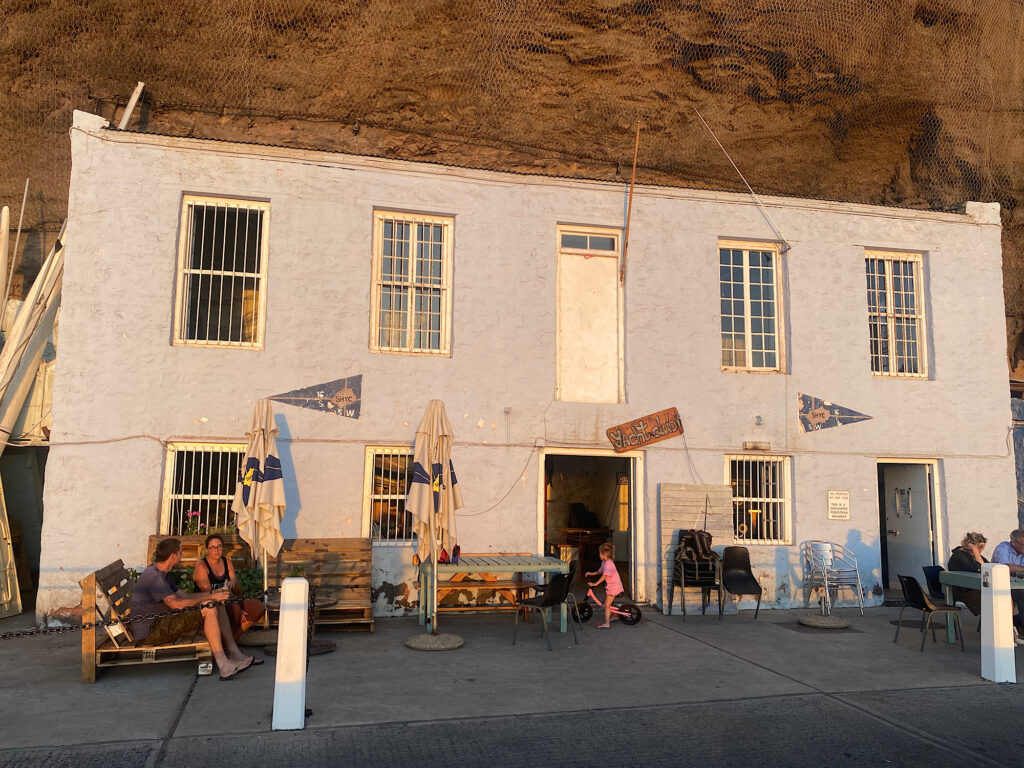
First on our tourist schedule the next morning was a tour around Jamestown with The French Consul. Michel Martineau has been on the island for over 30 years, looking after the historic ‘Napoleon’ sites (which are all owned by France) as his father did before him. We had an interesting tour finding out about the history of the town and about the fortifications designed the repel French and other invaders and especially to prevent any attempts to rescue ‘the ogre’, as he was known to English children in the early 19th century. When Hugh asked Michel whether he thought Napoleon was a hero or a villain, the French Consul laughingly and diplomatically answered ‘neither’.
The following day we’d arranged a Napoleon tour with Charles in his bright orange taxi, and were joined by Keith and Emily. First was a visit to the Pavilion at The Briars where Boney first stayed as a guest of the Balcombe family and had a happy two months, forming a special attachment to their 13 year old daughter, Betsy. It had a wonderful ambience with extensive gardens and a warmth and fragrance in the air, so one could imagine how he might feel at ease after his two month sea journey to St Helena. The French Consul was again our enthusiastic and knowledgeable guide.
[easy-image-collage id=7666]Then on to Longwood House, which was sold to the French government in 1858 and is where Napoleon lived for a further five years with some of his entourage of around 20 officers, secretary and servants who had come with him into exile in 1815. He occupied himself with writing his memoirs but was apparently very unhappy here with the accommodation and his treatment by the Governor, Sir Hudson Lowe, who loathed Napoleon and was terrified he might escape (despite the two warships circling the island and the extra two thousand soldiers stationed here). Longwood House is set on a bleak plain with a damp climate, exposed to the tradewinds. Napoleon became increasingly unwell for the last year of his life and and died in 1821 at the age of 52. He was buried at his request in Sane valley, a tranquil and lovely spot surrounded by tall pine trees and the last stop on our tour. In 1840 his remains were exhumed and returned to France and are now in Les Invalides, within sight of the Seine as he’d wished.
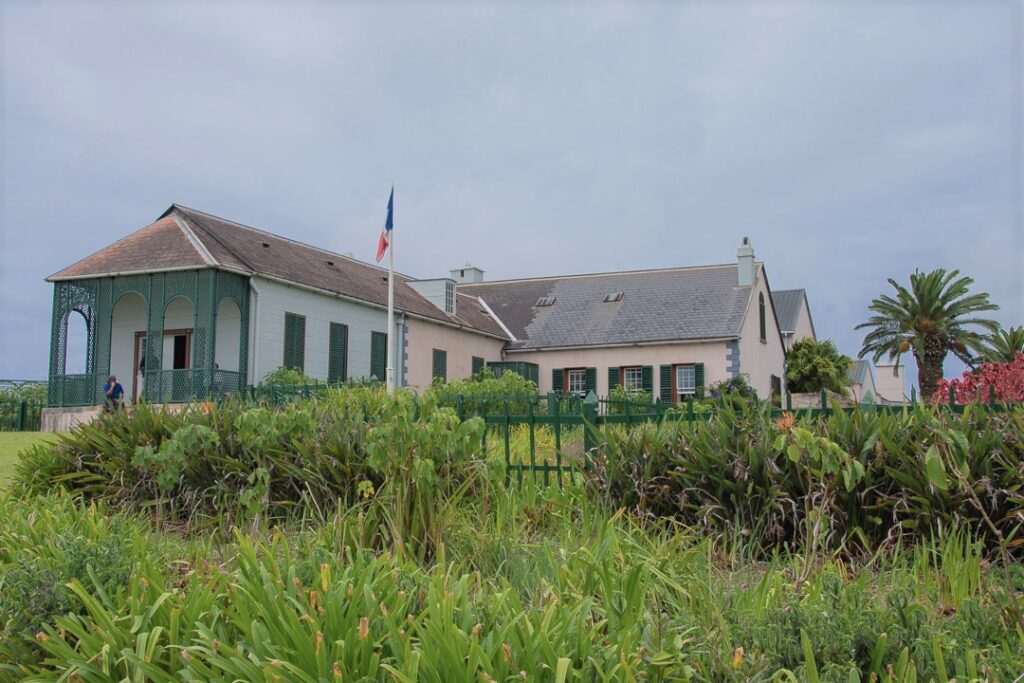
Although the island is only 6 miles wide and 10 miles long there is still plenty to do and see. Lots of great hikes and scuba diving, with whale sharks a highlight. It’s not necessarily the kind of place your average holidaymaker would want to visit though. Despite the tropical climate there are no golden sand beaches with palm trees, only one rather dismal, black sand beach, no resorts and a dearth of hotels and fine dining experiences. Up until a few years ago St Helena was rather hard to access, only by the RMS St Helena, a five night trip from Cape Town, which brought both cargo and passengers (unless you came by private yacht of course). After many years of negotiations an airstrip was finally built and opened in 2017. Initially problems with crosswinds which made it difficult for larger planes to land caused it to be dubbed the “world’s most useless airport”, but since then smaller commercial planes have proved it to be safe. According to the UK Government estimates, up to 30,000 visitors per year could visit Saint Helena Island once air links were established. The hope was that there would be an influx of visitors bringing a much needed boost to the island’s waning economy but then came Covid. The building of the airstrip was controversial and not universally welcomed by the Saints. It cost £285m paid for largely by the U.K. government. One advantage is that it enables urgent evacuation of medical emergencies from the island. With flights costing over £800 return for the 4 1/2 hour weekly flight from Johannesburg it is a deterrent for both locals and tourists. The majority of passengers are Saints visiting South Africa to see family, go shopping or get hospital treatment and each flight may bring only about ten tourists. They have gained the airport but lost the RMS St Helena, previously the island’s lifeline and a popular way to travel, with only infrequent cargo ships carrying goods that cannot be brought by plane.
Another day we caught a local bus to join a guided tour around Plantation House, official residence of the island’s governor from 1792 to the present day. We were shown the General’s bedroom where Princess Anne had slept during her stay on St Helena in 2002, the last ‘Royal’ to visit the island… the bed looked rather uncomfortable and the room spartanly furnished. The grounds are home to the island’s oldest resident, Jonathan, a giant tortoise. Jonathan was thought to be about 50 years old when he was brought from the Seychelles in 1882, which makes him about 190 years old now. Since then three companions have been introduced but sadly no baby giant tortoises have resulted.
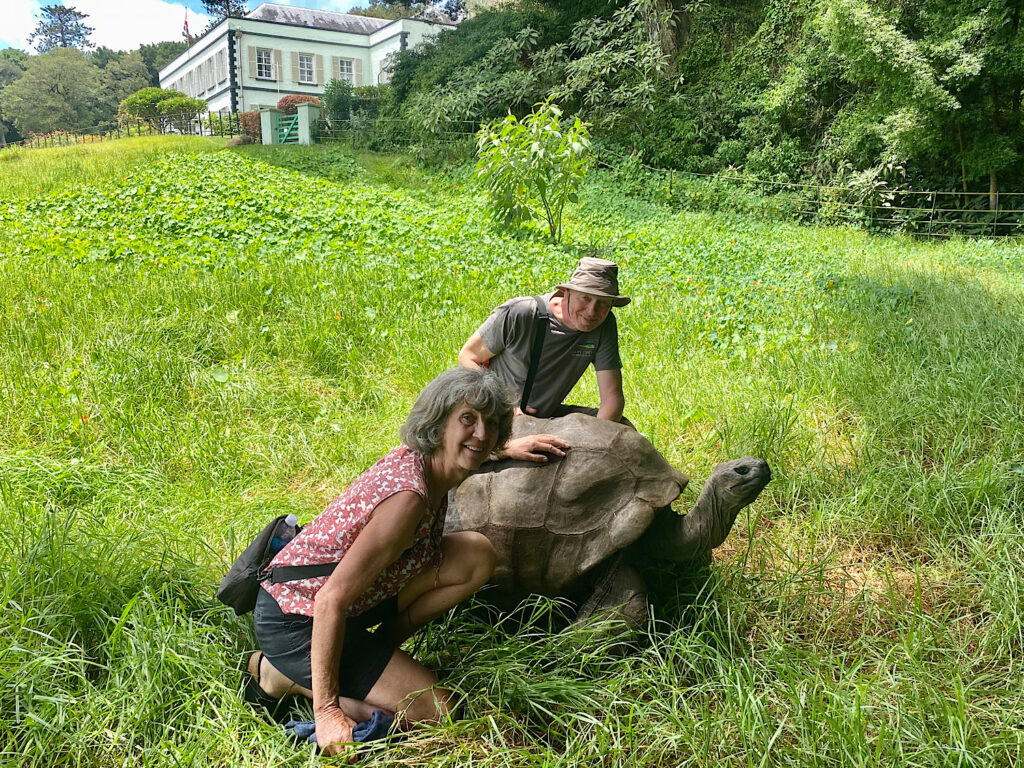
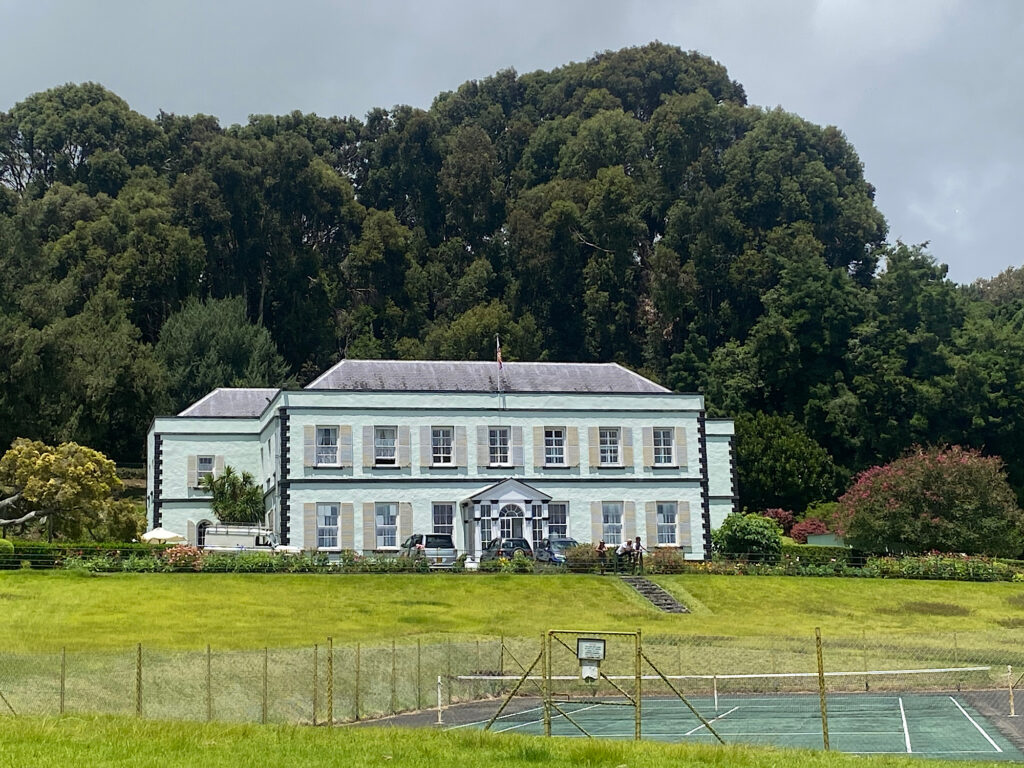
We toured around the island with Aaron’s Adventure Tours in his off-road vehicle. Leaving Jamestown along Napoleon Street, then climbing uphill along a steep road with hairpin bends, the scenery quickly changes from rocky and barren to lush and forested. Although a small island it appears much larger with steep mountain peaks and ravines, hills and deep valleys, and inland the scenery is amazingly diverse. We drove along narrow lanes bordered by flax, sisal and pine trees, past forests of eucalyptus to moorland with yellow flowering gorse, sheep and cows grazing (all non-native) and a rather pitiful wind farm. It was here on Deadwood Plain that there was a camp for six thousand South African Boer prisoners captured during the Anglo-Boer war of 1900-1901, and during Napoleon’s time there was a military camp for some of the extra soldiers stationed here. We continued east past the golf course to a desolate area supporting only clumps of cacti but with spectacular ocean views, trying to spot the native wirebirds, only found on St Helena. The St Helena Plover, known locally as a wirebird and the only remaining endemic bird on the island, features on the St Helena flag. Apparently Charles Darwin never managed to spot one but we saw several hopping around on the ground, too far away to get a very clear photo. There are also white tropic birds here with long tails, fairy terns, Indian Minah, Java sparrow birds, all immigrants from overseas but strangely no seagulls.
On to the Millennium Forest where there are attempts to reintroduce the native gumwood trees which used to cover the island but were mostly cut down for fuel and timber and to make way for agriculture and imported crops such as sisal. From here we could look down to the airstrip, built on the only suitably flat area of land on the island, but even so requiring removal of 30 meters of hillside. In the centre of the island is pastureland overlooked by mountainous Diana’s Peak, the highest spot on St Helena. Below, the landscape is a kaleidoscope of green, with rolling hills and rich pastures spread out like a patchwork. To the south and west the scenery is more wild, with spectacular rock formations such as Lot and Lot’s Wife, Gorilla’s Head and Asses Ears, geological remnants of a once violently active volcanic outpouring between tectonic plates.
St Helena is in the tropics but its climate is kept mild by the southeast trade winds, those winds that wafted us here from South Africa. The climate is perfect for growing coffee and there are two coffee plantations in a fertile valley in the southwest. The brand of bean, Green Tipped Bourbon Arabica, is unique in that it is grown nowhere else in the world. We were told that a 125g bag, which you can buy here for £10, retails for £90 in Harrods, making it one of the most expensive coffees in the world and the only coffee produced on U.K. land.
We ended our tour driving through Half Tree Hollow, the largest settlement on the island, high on the cliff overlooking Jamestown. The name conjures up hobbit houses with bunny rabbits hopping around the village green, but disappointingly it is a sprawl of characterless bungalows, a few unexciting-looking shops and the Princess Royal Community Centre. The graffiti on the cliff which once read ‘Welcome Prince Andrew’ has thankfully now faded.
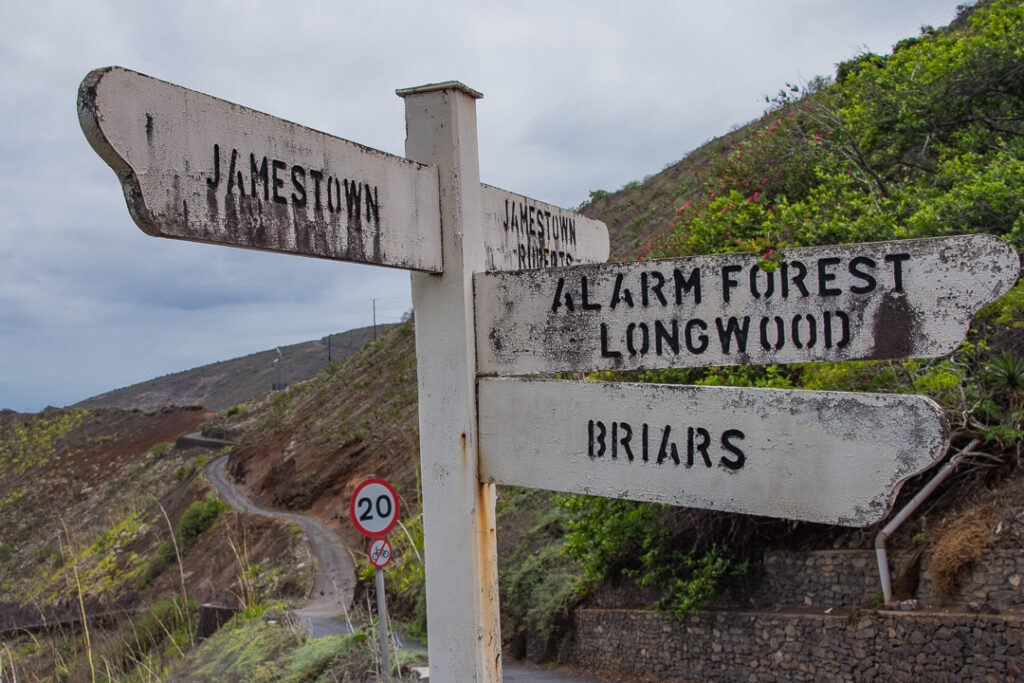
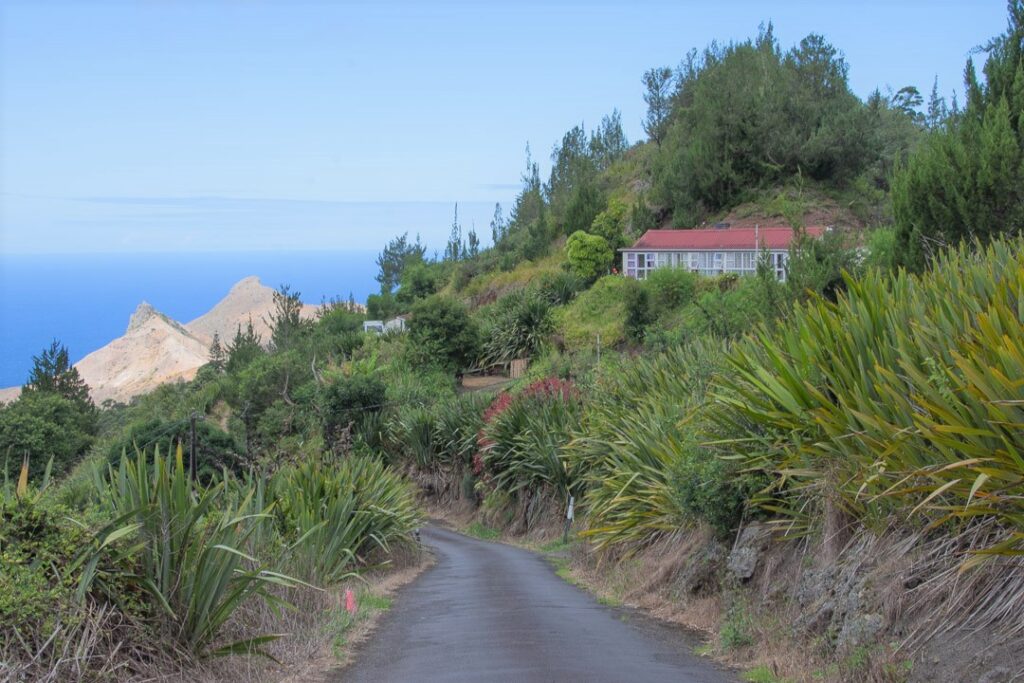
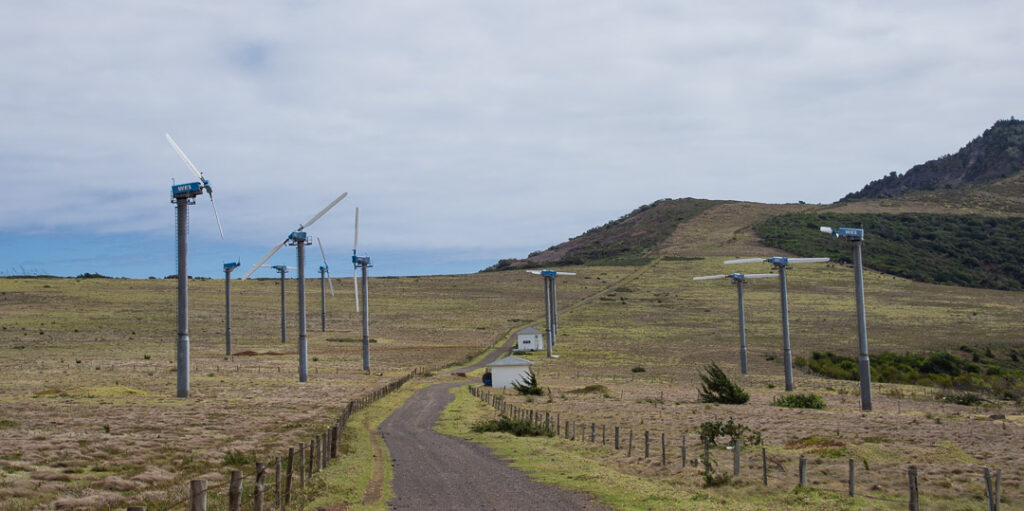
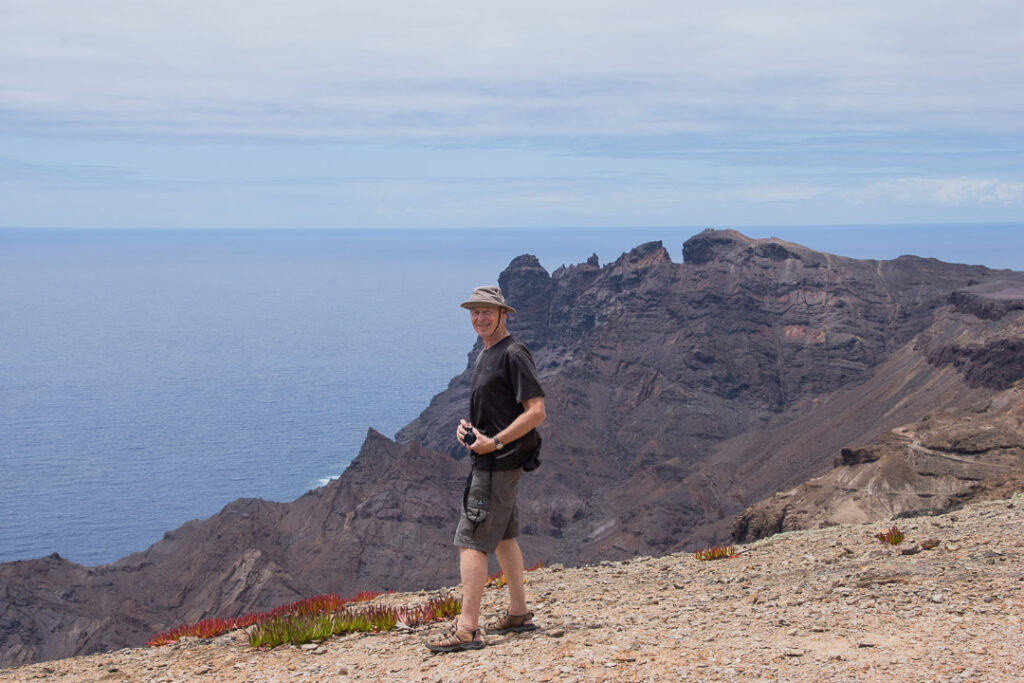
The rugged coastal landscape
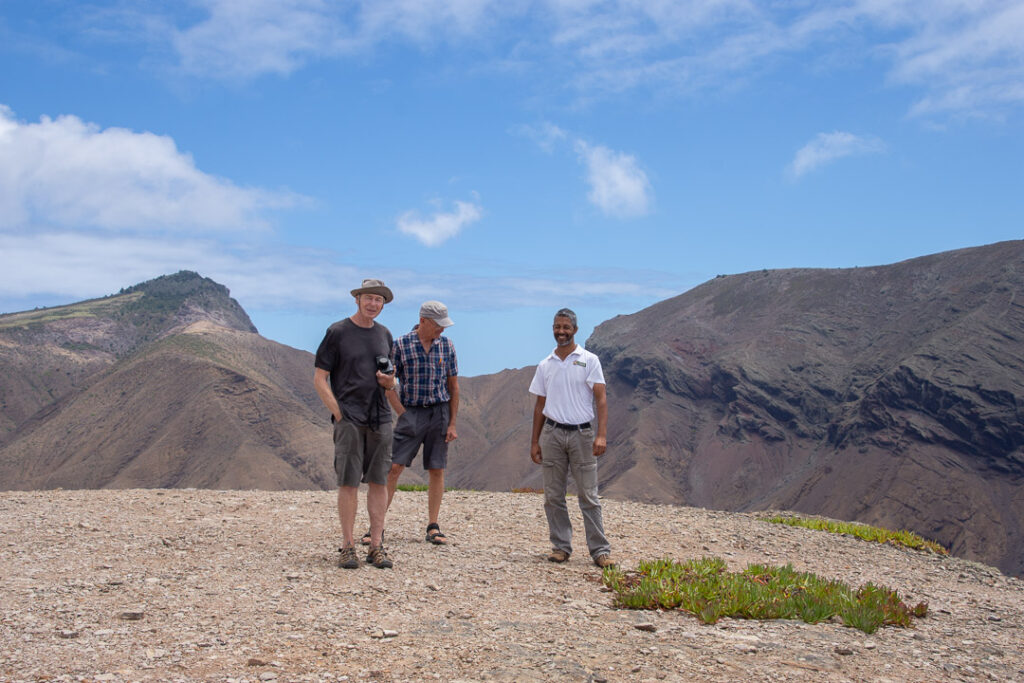
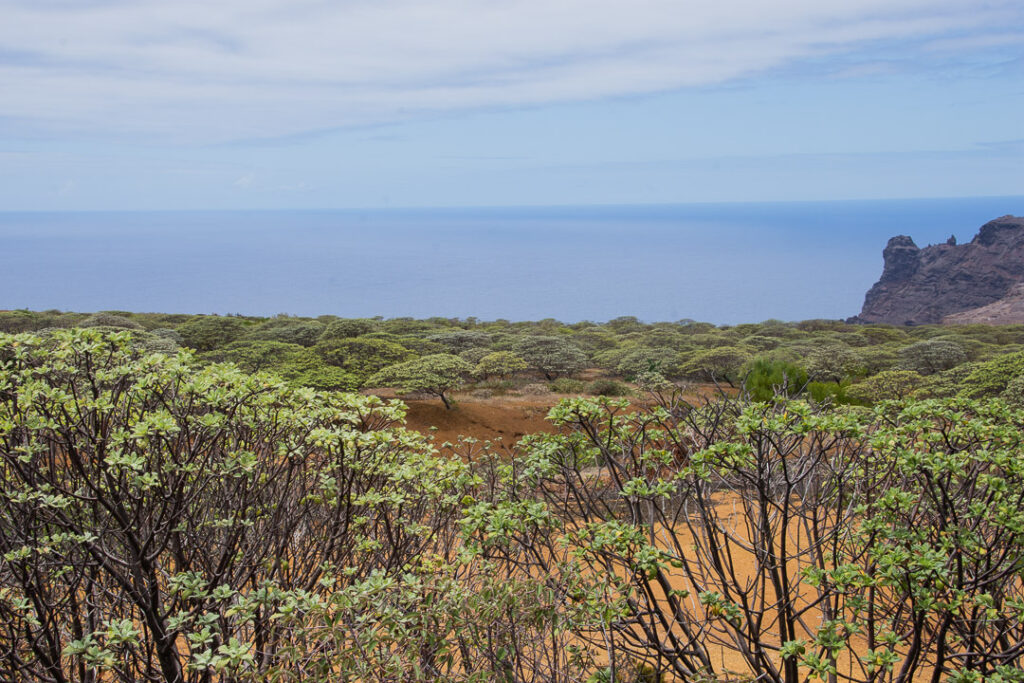
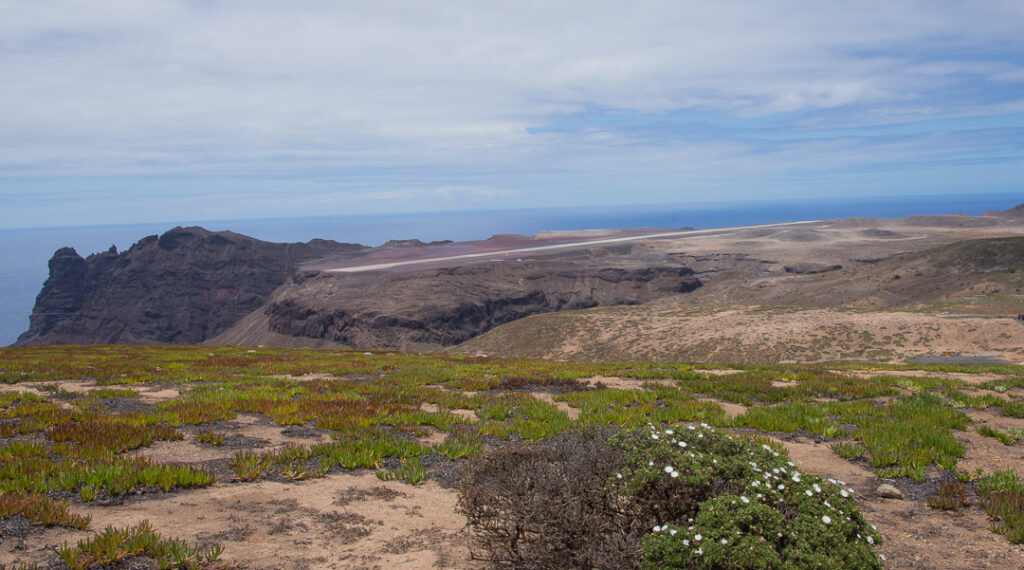
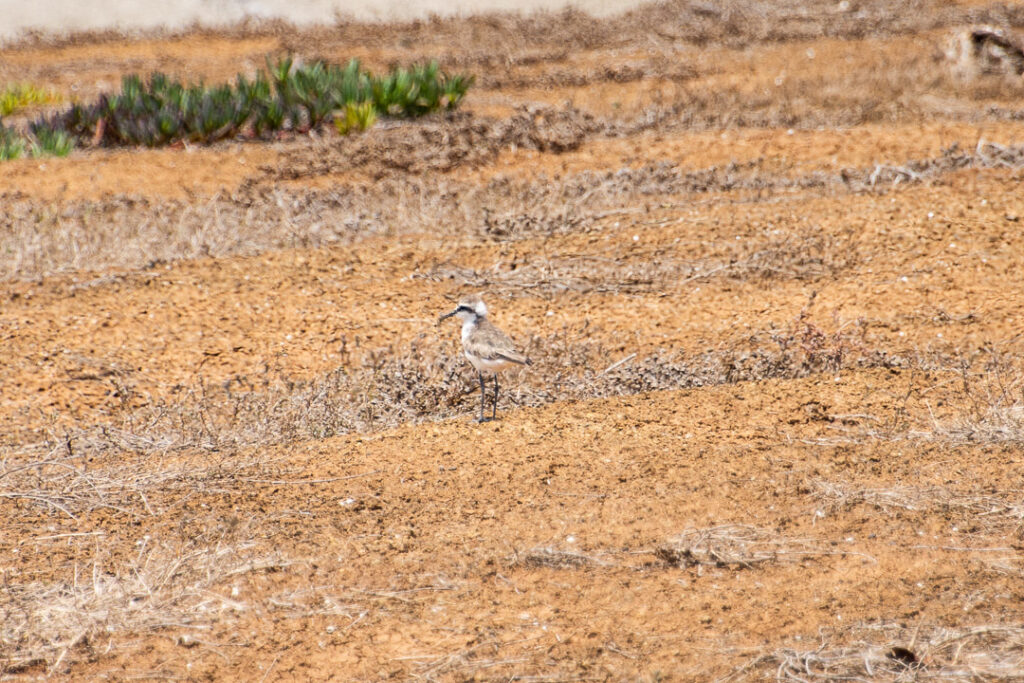
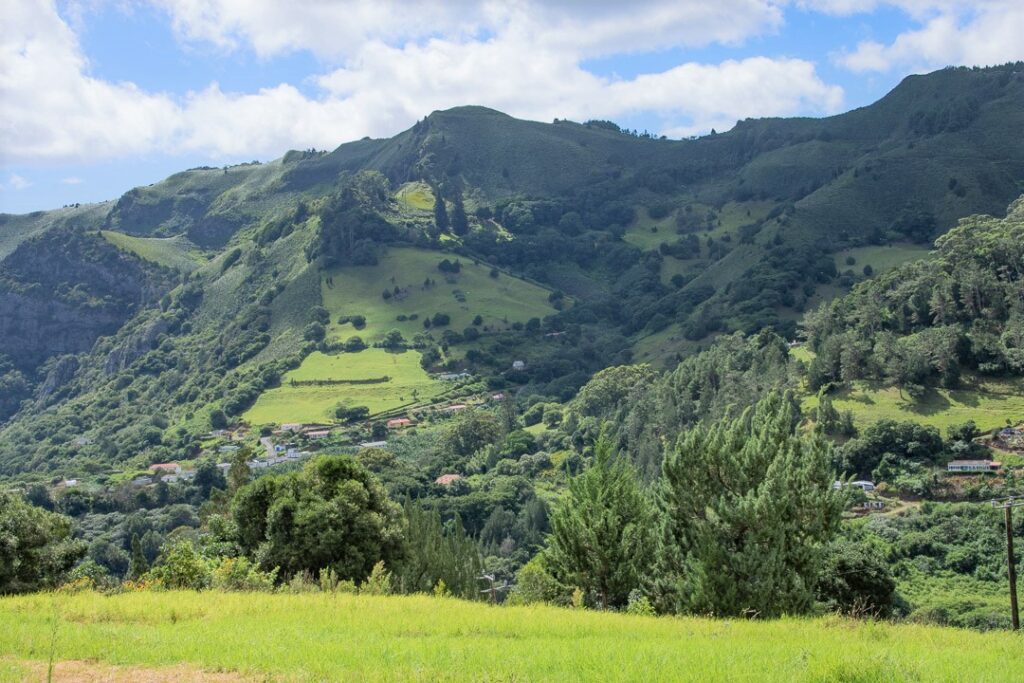
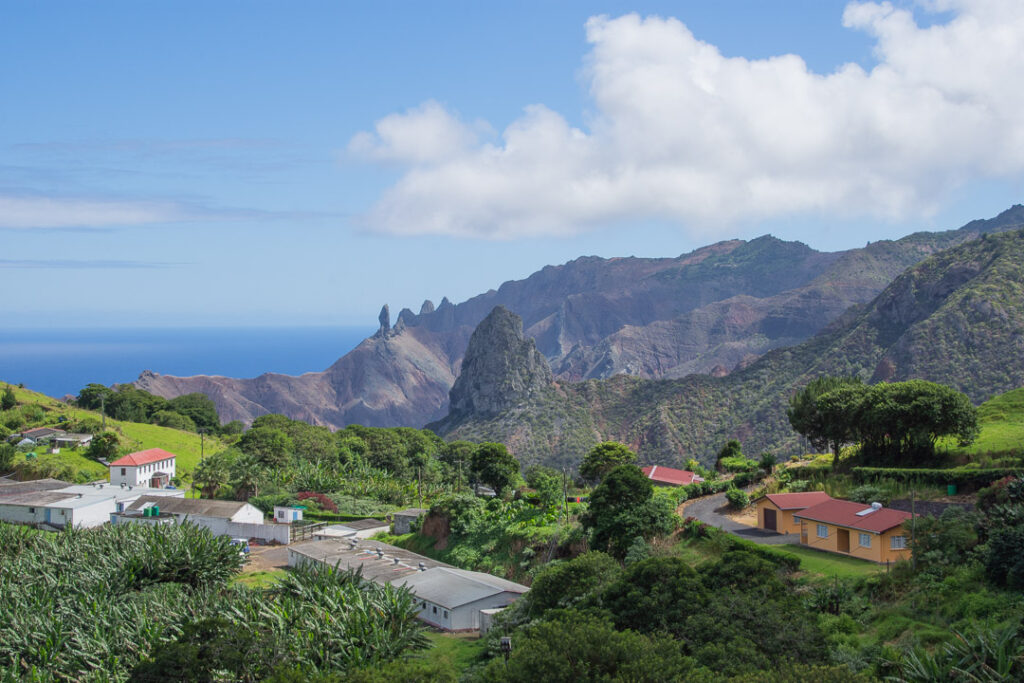
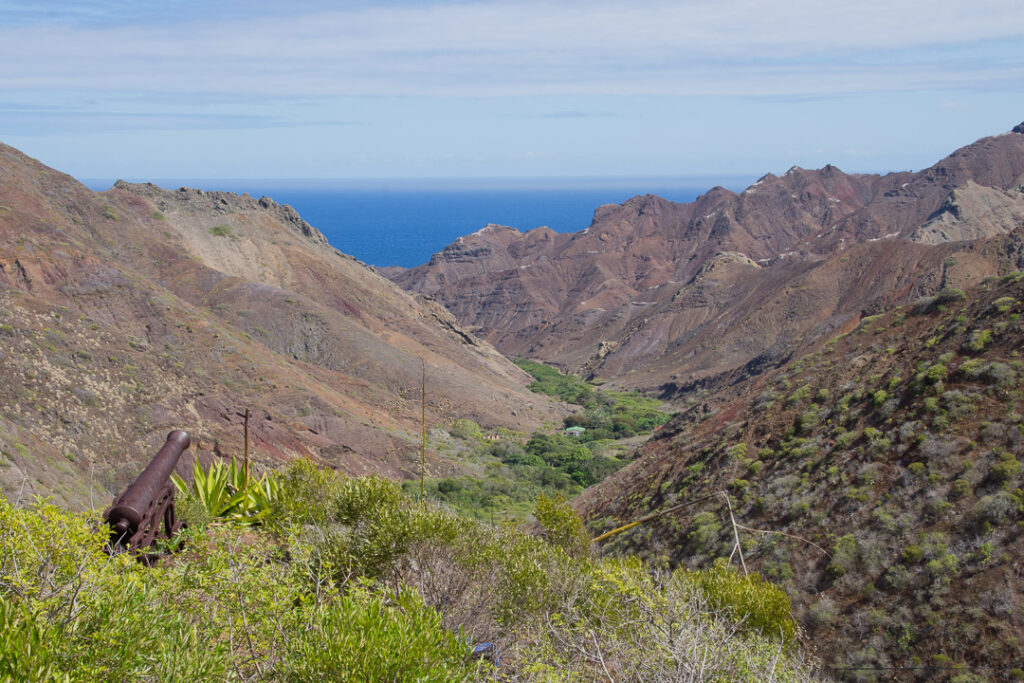
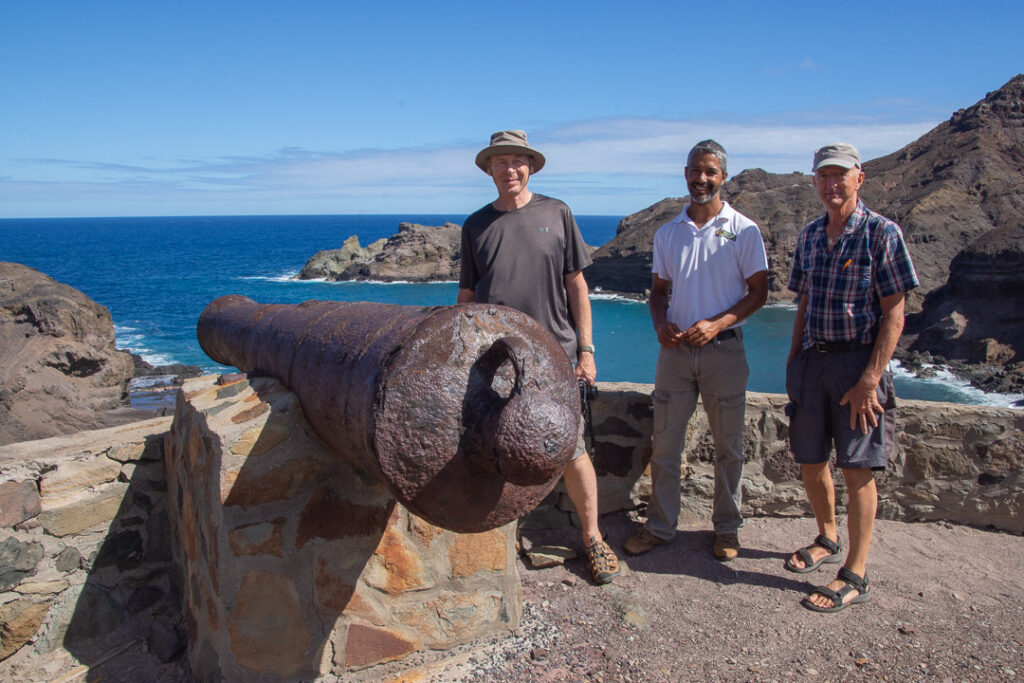
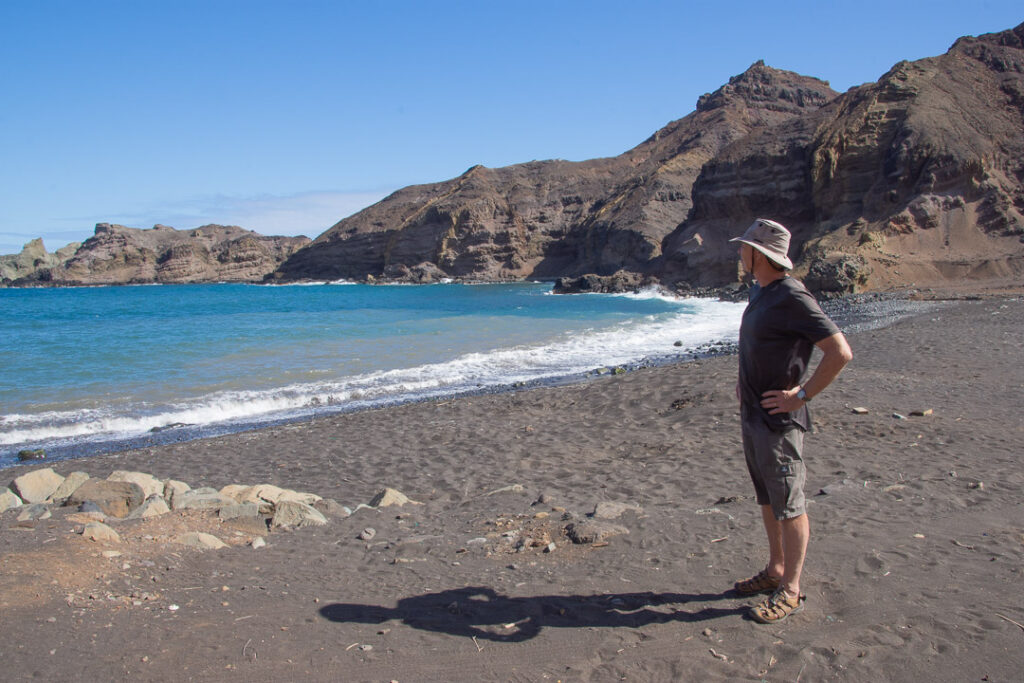
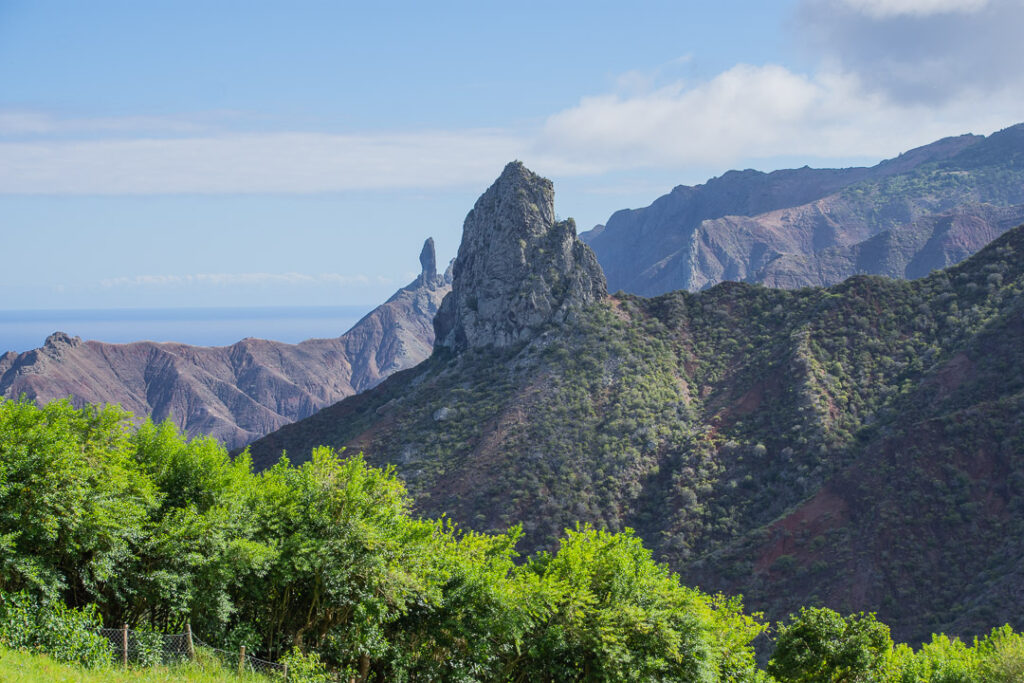
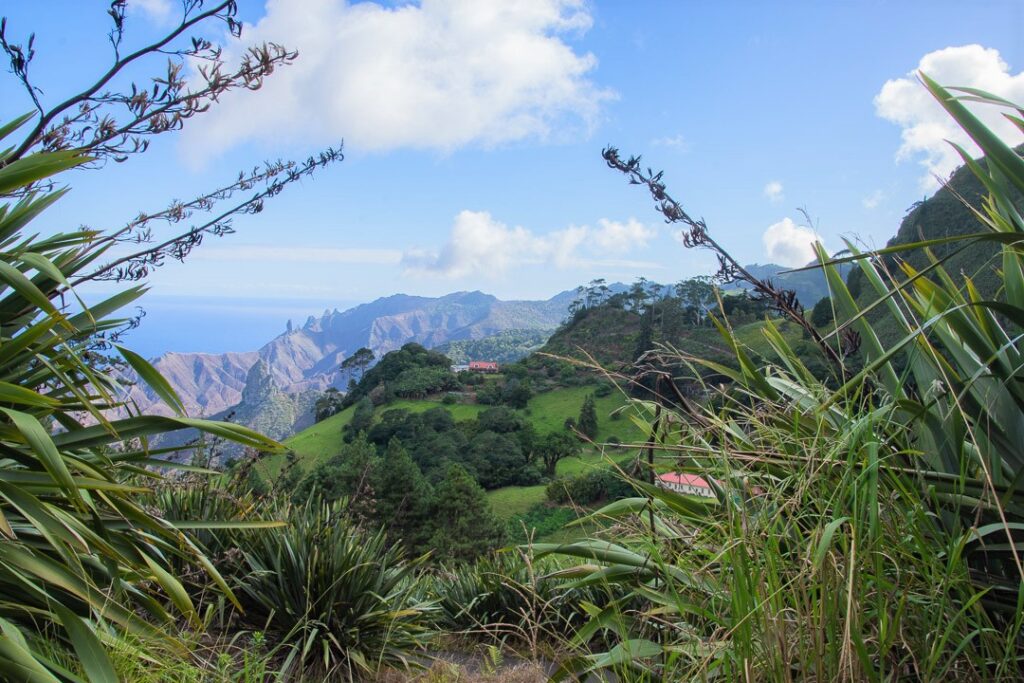
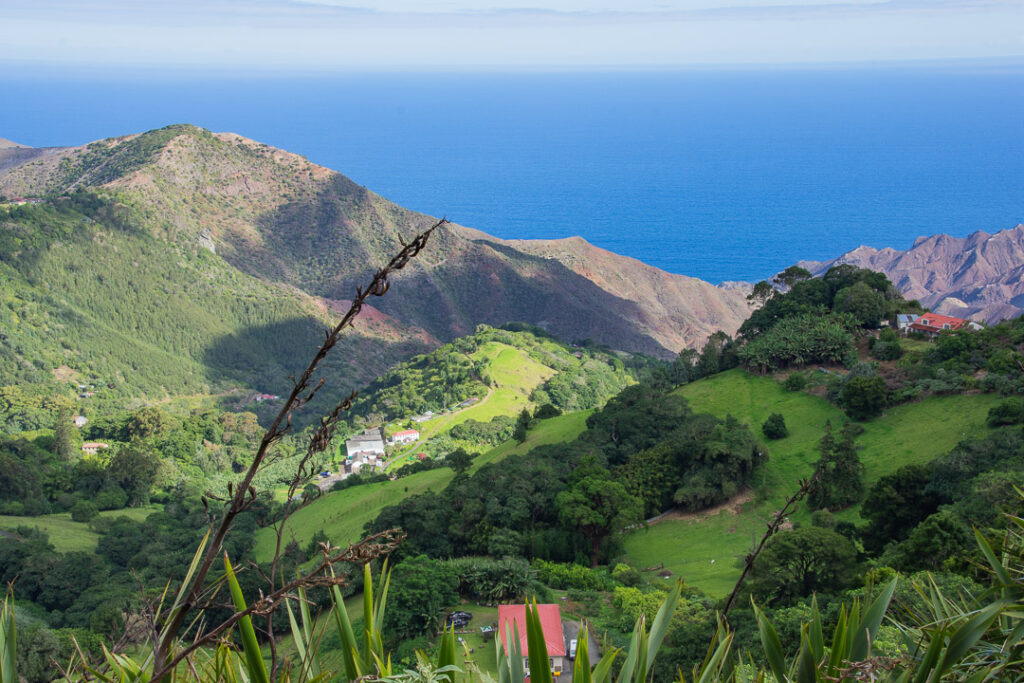
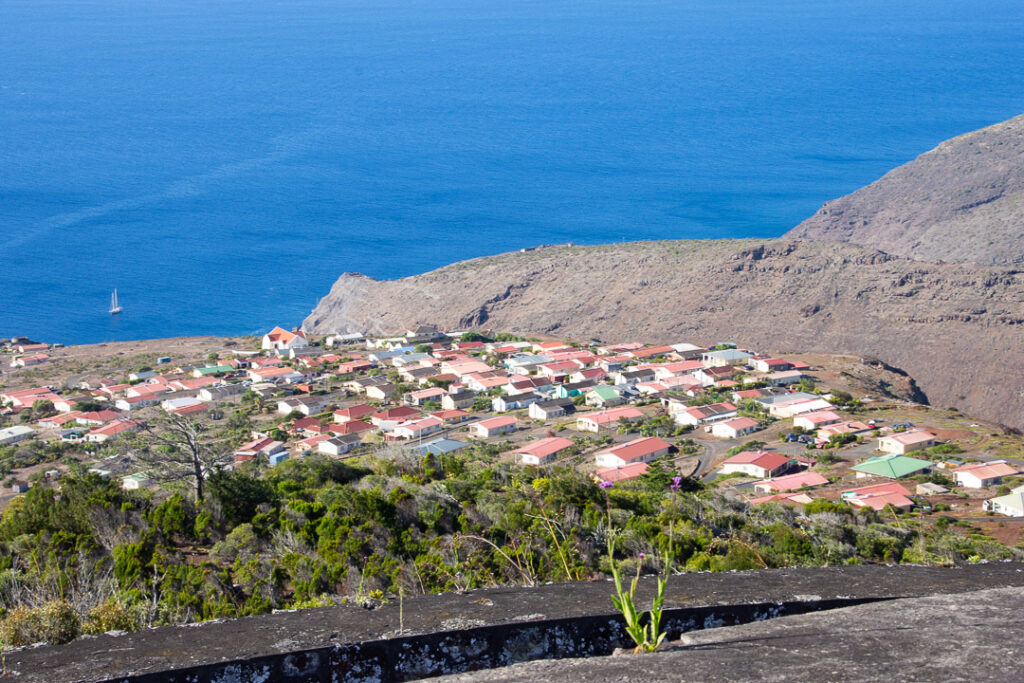
The next day we had planned onboard Vega doing boat chores until I spoke to EmilyLuna who were about to go on a snorkelling trip looking for whale sharks. I grabbed my bathers, camera, mask and towel and was ready by the time the ferry drew up alongside to take me to the tour boat. We hadn’t gone far beyond Jamestown Bay when a dark shadow was spotted in the water and we quickly jumped overboard. The huge shark swam slowly around, coming within a foot or two of us at times, several remoras (sucker fish) hitching a ride on it, until after about 30 minutes it lost interest in us and with a few flicks of its tail headed off.
Whale sharks can grow up to 40 foot long and are the world’s largest fish, docile creatures which feed off plankton and small fish. A few days later Hugh was on deck when one slowly swam by, just below the surface of the water, almost as long as Vega.
Along with Anne’s Place our favourite hangout was the Consulate Hotel, a place of decaying grandeur, over 300 years old, most of its furniture probably that old too and full of pictures celebrating the island’s maritime history. It is where to go for morning coffee and afternoon tea, to sit on their verandah overlooking the main street and watch the world go by. Hazel, the elderly owner from Botswana, was suffering from back pain due to an osteoporotic ‘dowagers hump’ and only managed to put in an occasional appearance. Her friend Peter was helping her run the hotel, a man with a colourful history who was a great source of island gossip. It was frequented by ‘characters’ such as the frail, elderly gentleman who was once David Attenborough’s cameraman. He had numerous anecdotes about his time in the African bush which he could remember with clarity although he was rather confused as to what was going on nowadays. Peter told me they could no longer care for him at the Consulate due to his Alzheimer’s, so arrangements were being made for a care home in the U.K. where he knew no one. Very sad.
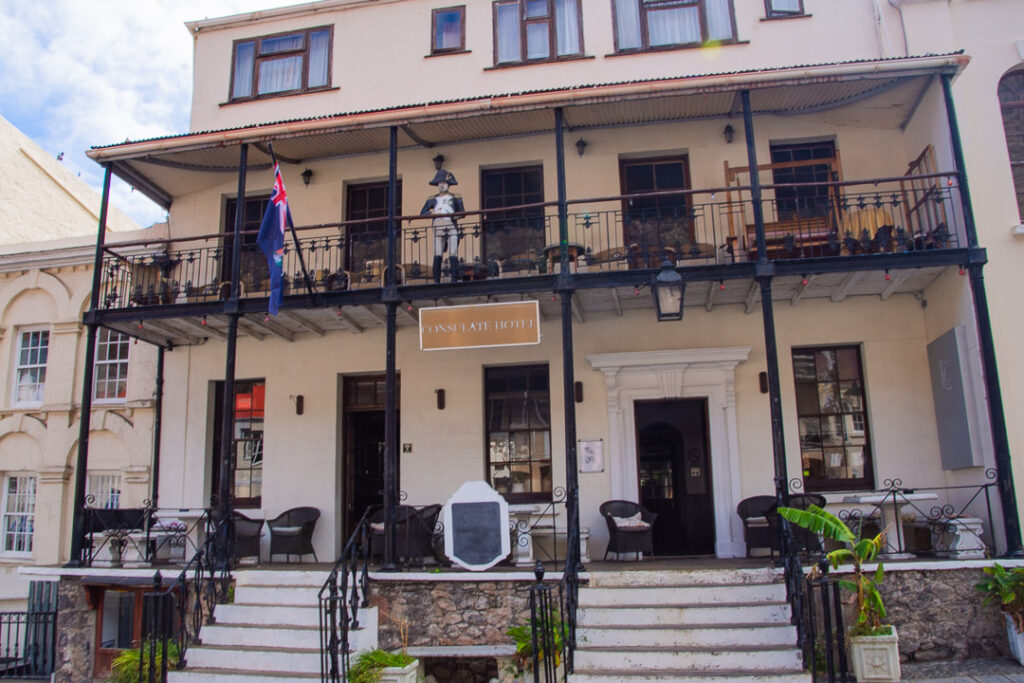
Although the island does have a cell phone network known as Sure, SIM cards and data were expensive and the signal unreliable, so most Saints use old fashioned landlines to stay in touch. One advantage of this was people would actually talk to each other, rather than everyone with their faces stuck in their mobile phones. The disadvantage was that the young people instead hung around in groups in the Public Gardens with music blaring out loudly from their ghetto blasters. With no reliable cellphone network or wifi this is a cash economy, no swiping plastic here. U.K. sterling is accepted currency as well as the local St Helena notes. Hence also the well-stocked video rental store on the island as streaming Netflix movies is not an option. We could buy Wifi for £3.30 for 30 minutes at a limited number of locations including Anne’s Place and The Consulate Hotel.
There were several other boats at anchor here including Grand Lux with Robert, a French Canadian, who we’d first met in the Seychelles. Henry, an American single-handed sailor on Ceres, who we’d met in Richard’s Bay, South Africa, and who joined us on Aaron’s island tour. We’d also first come across Christophe and Carina in Richard’s Bay, a young French-Estonian couple on L’Envol,. They are sailing the world on a strict budget and so had hitchhiked when going to see the heart-shaped waterfall. A couple of Saints had given them a lift and decided to adopt them, inviting them on a tour round the island the following day. They seem to love yachties on St Helena as we tend to stay a week or more and are genuinely interested in getting to know St Helena as well as injecting much needed currency into the island economy. We are much preferred to the occasional visiting cruise ship which only stops for a day, the passengers going on a quick tour around before pronouncing ‘I couldn’t live here’.
As is usual at any of these stops there were jobs of a more mundane nature to be done. The Duogen had broken on the way here and Hugh traipsed around the hardware shops looking for glass fibre resin and epoxy to repair it, without success. He borrowed some fibreglass from Keith on EmilyLuna and local mechanic Adrian made up stainless steel strips to support the break (we were hoping the repair would last to Antigua where a replacement part will be delivered… it did). We left our dirty laundry at Annie’s Laundrette to be collected a few days later. One priority was restocking with fruit and veg as we were down to our last butternut squash and sweet potato. Thursday is ‘market day’ when the locals bring their produce into town to restock the supermarket shelves with fruit and vegetables. You have to get there early as it sells out quickly. Eggs are flown over from South Africa and I never managed to find any on the supermarket shelves. Aaron told us how there used to be an egg farm on the island but someone had the bright idea of giving all the islanders their own hens so they could be self sufficient in eggs. The fun of caring for hens soon palled, the hens were allowed to run wild or were eaten but in the meantime the egg farm had closed. So now eggs and frozen chicken are imported. Similarly all milk is UHT and imported as there is no dairy on the island, although there are plenty of cows as well as sheep and pigs. At one time there was a thriving flax industry here, supplying the British Post Office with flax fibres to bind bundles of letter. The rubber band and the Internet put paid to that.
St Helena could probably not survive without support from the U.K. and receives around £28million annually in aid. The population of 4,000 is dropping as many young people move away. The teenagers are paid £350pm to stay on at school and many of them go on to college in the U.K., few returning permanently. It can work the other way round too and Rick, the hairdresser I visited, had come over age 19 with his mother, a Saint, who had herself left the island for the U.K. when she was 19, married a soldier and settled in Aylesbury. Rick liked the quiet life here, married a local and now has teenage children of his own. There are a significant number of expats here, many of whom are married to Saints. Of the 4000 residents about 1000 work for the St Helena government and many work offshore in the U.K., the Falklands and Ascension Island, where there is a US base, to help support their families.
We left after 10 days, longer than we’d originally intended to stay but it was a difficult place to tear ourselves away from. Joshua Slocum, who did the first ever single-handed voyage around the world in his 37 foot sloop ‘Spray’, felt the same, commenting in his book ‘Sailing Alone Around the World’ (which is an excellent read, even for non-sailors) that he was ‘loath to leave’.
EmilyLuna headed off the day after us. They been waiting to get lifted out by crane for repair of their broken prop-shaft, but there was always too much of a swell to safely manage it. Eventually Adrian came on board and was able to effect a reasonable temporary repair without the yacht being taken out of the water. They were hoping not to have to motor much on their passage on to Grenada.
We were heading towards Antigua in the Caribbean, almost 4000 miles away and over a month at sea. For most of the way we would be in the trade winds and were hoping for easy, gentle ‘milk run’ sailing. About half way we would be crossing the equator and that area known as the doldrums or the ITCZ (the inter-tropical convergence zone) of no or changeable winds with possible storms and squalls.
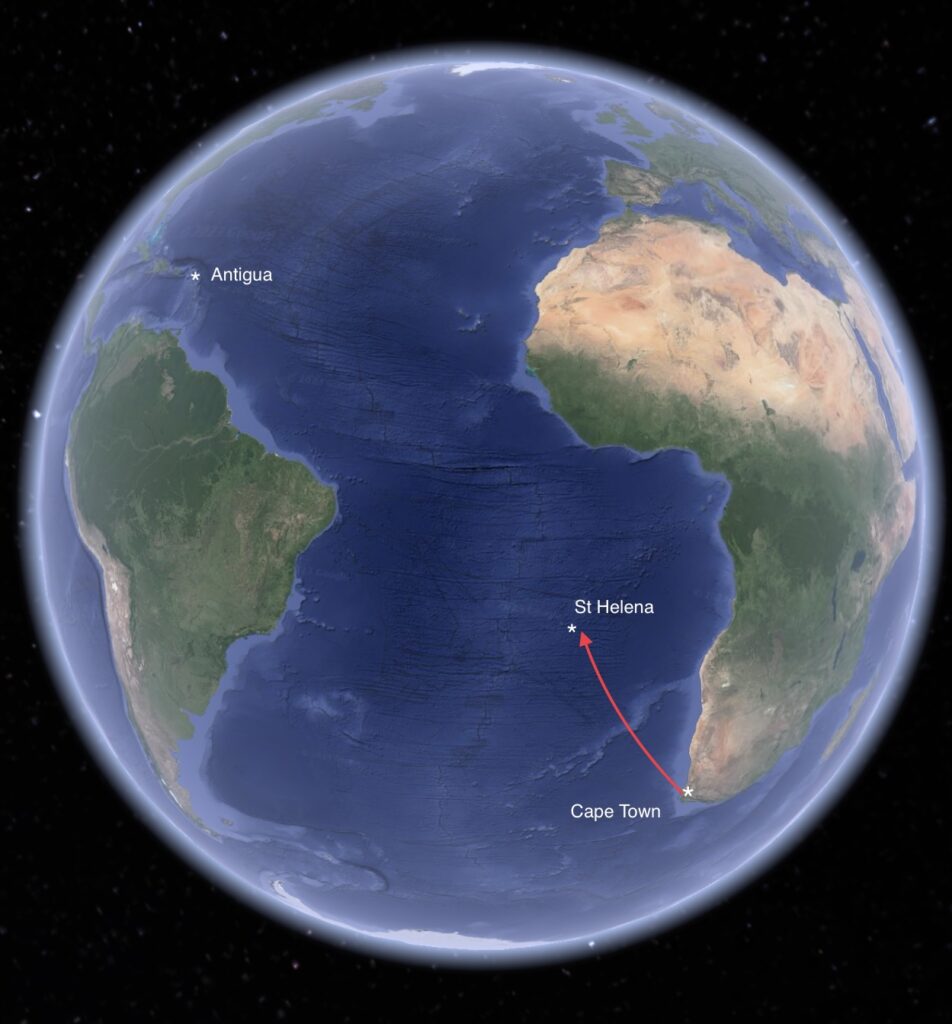
If you want to know more about this fascinating island then do visit the website:
http://sainthelenaisland.info/index.htm
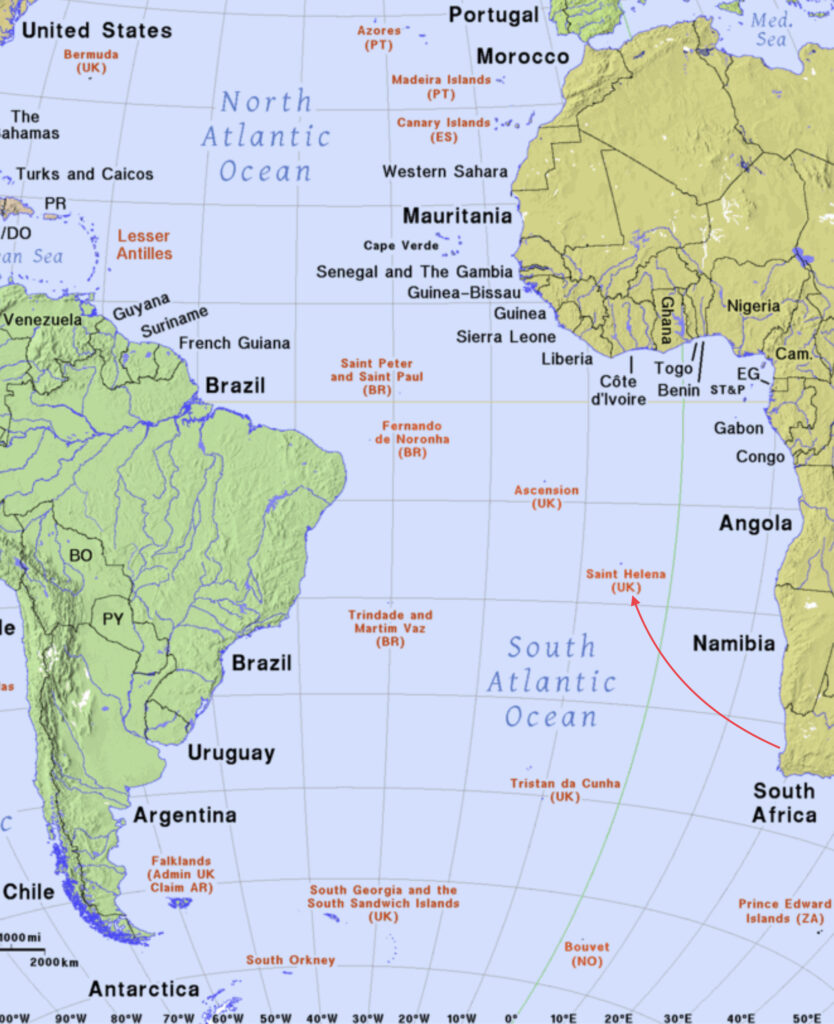
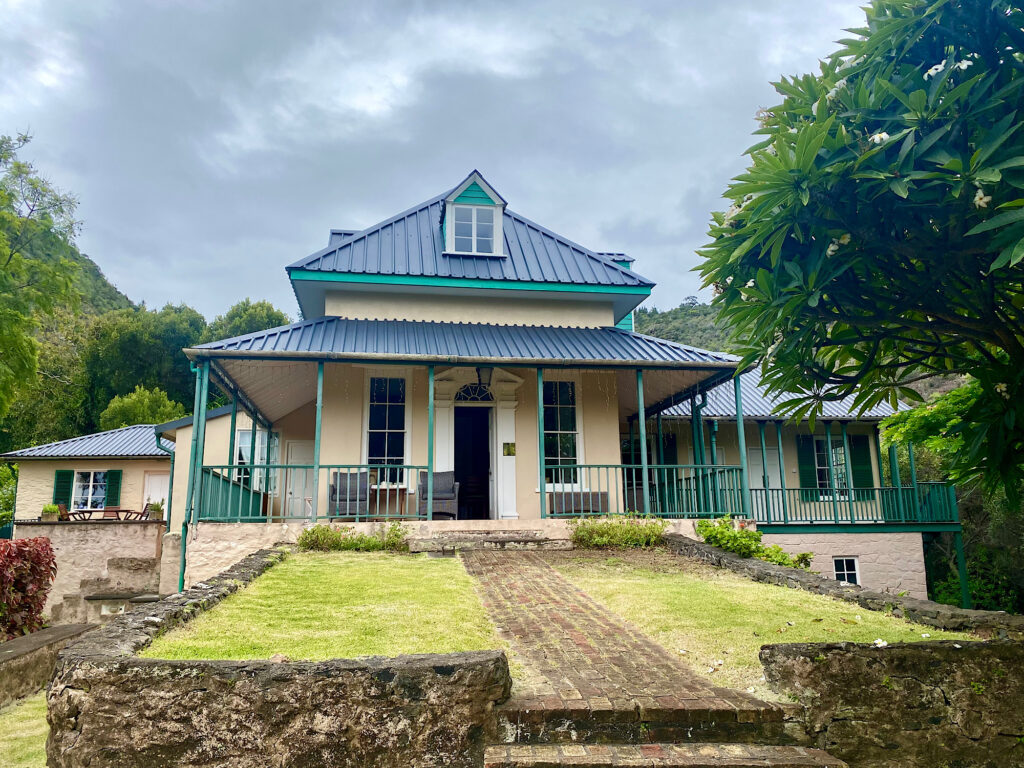
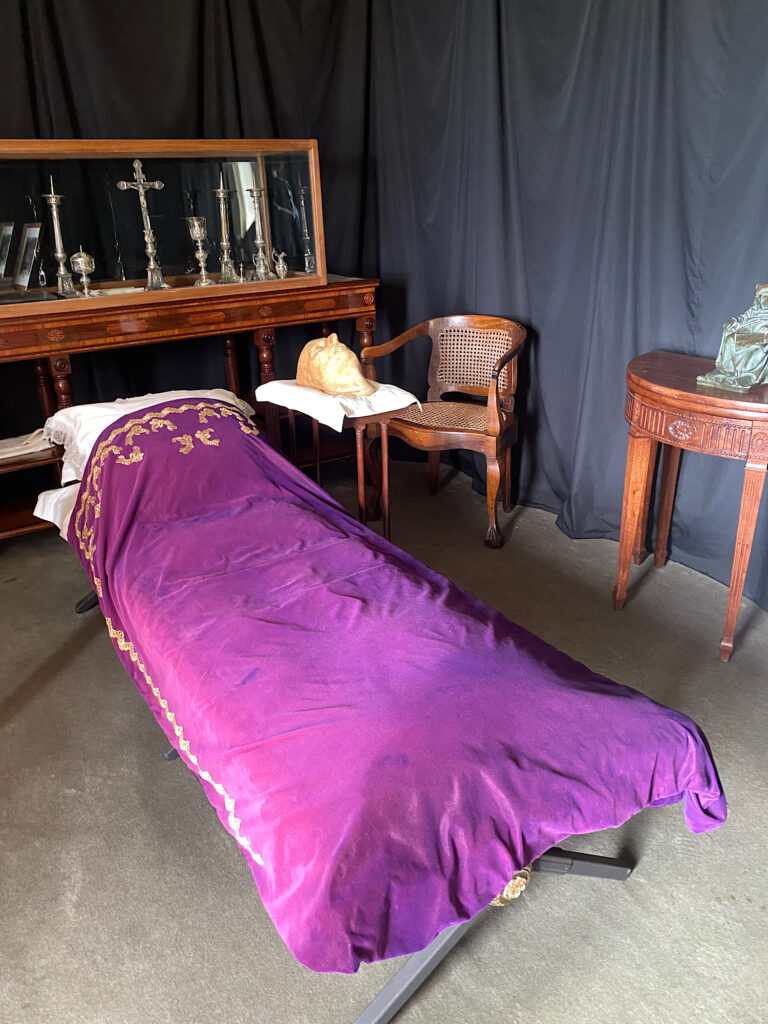
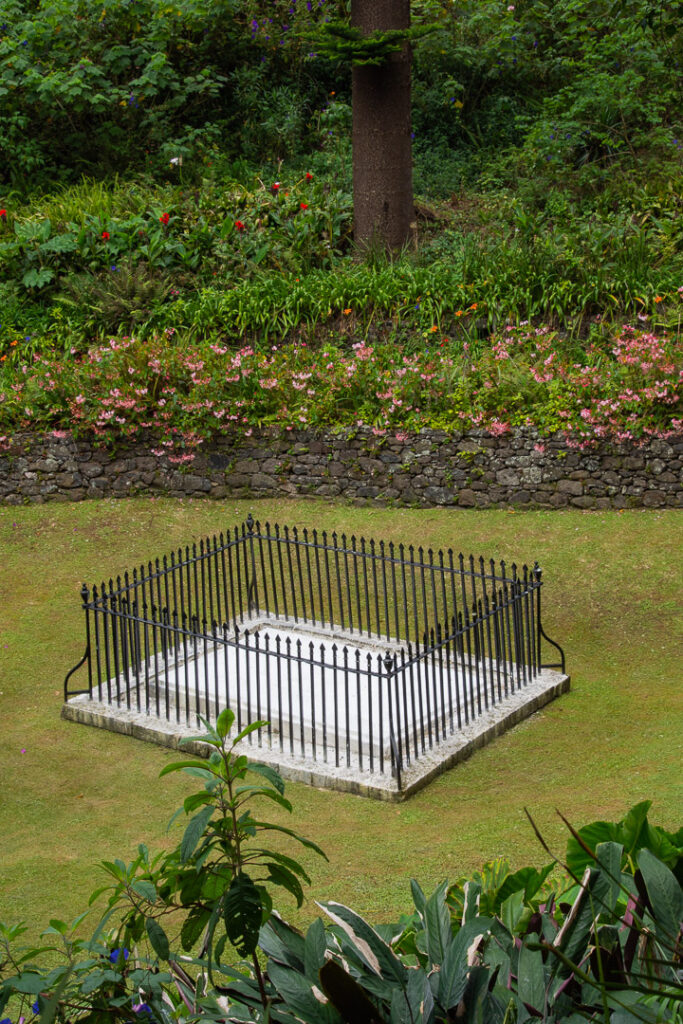
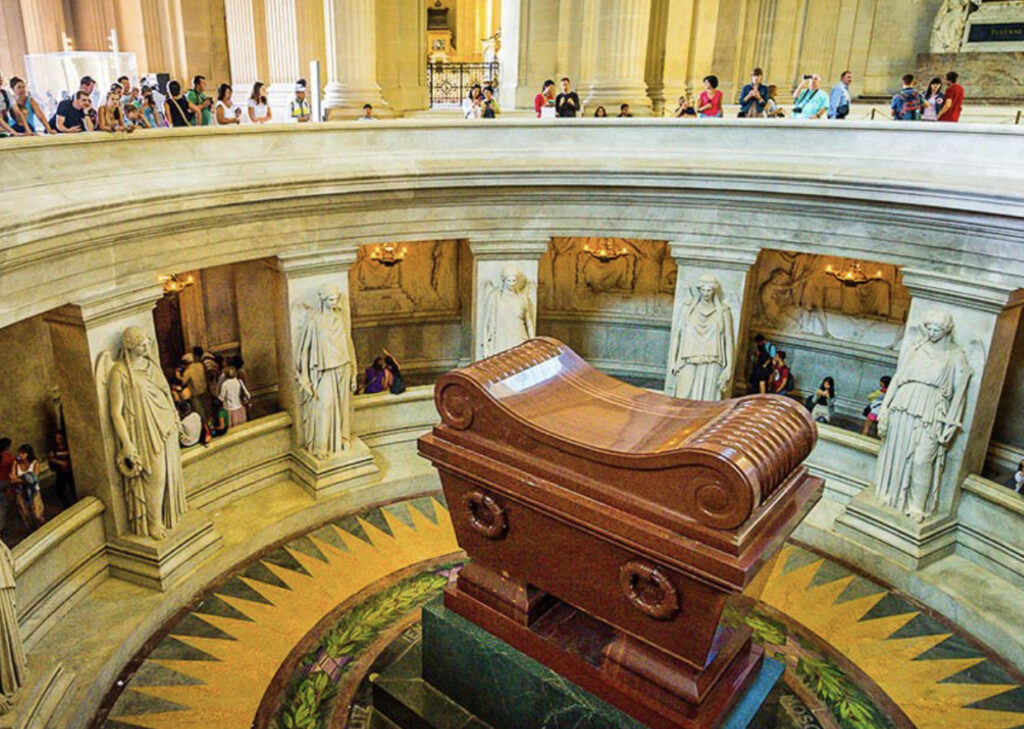
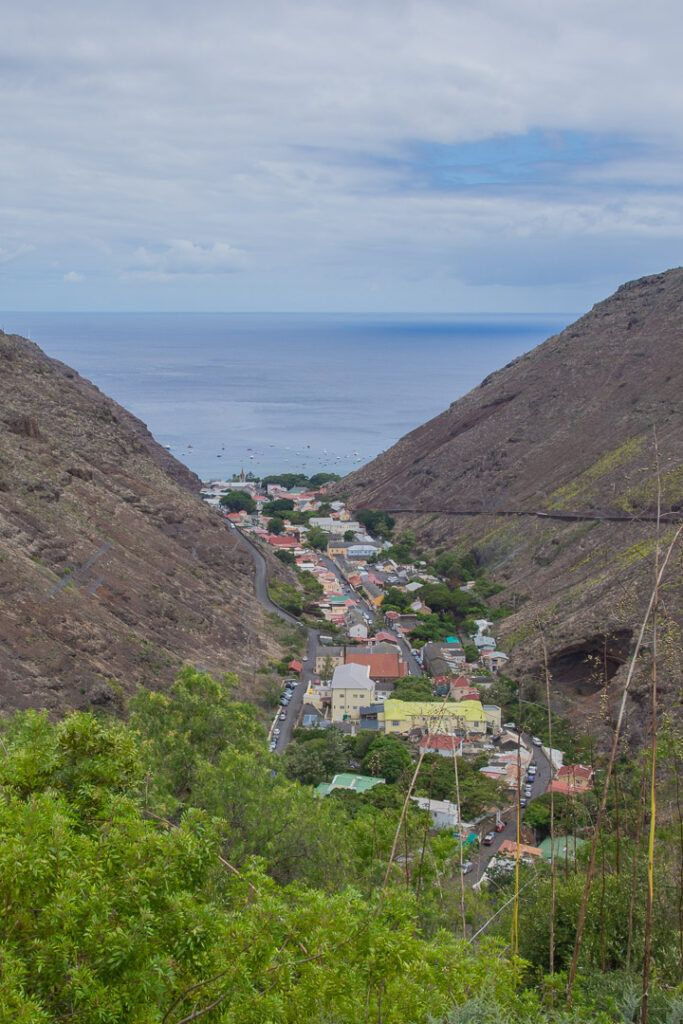
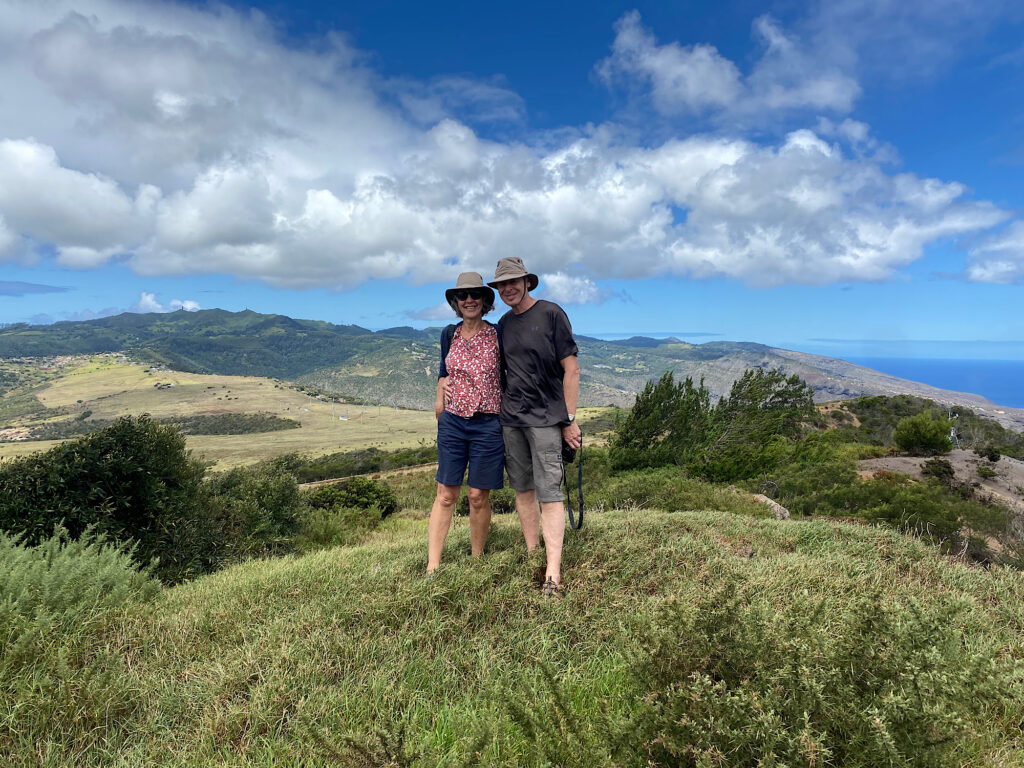
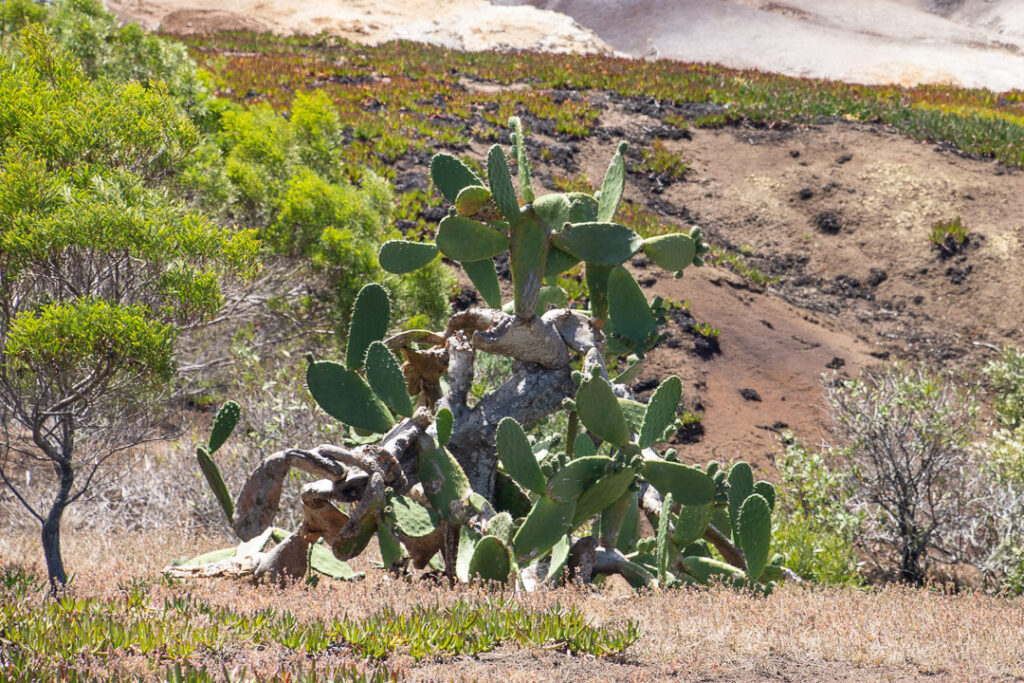
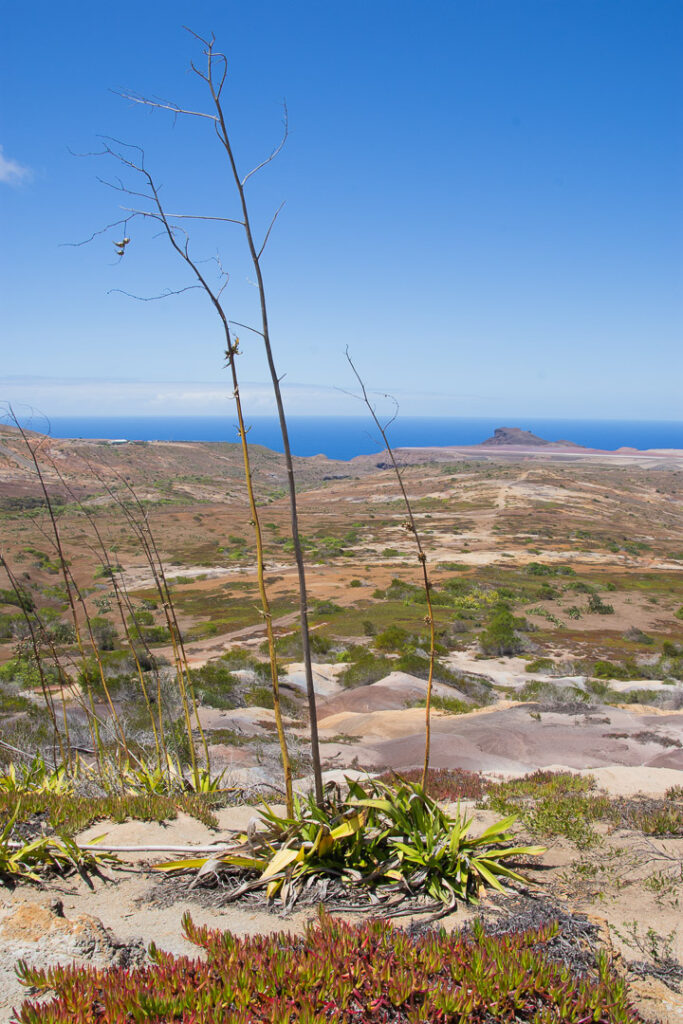
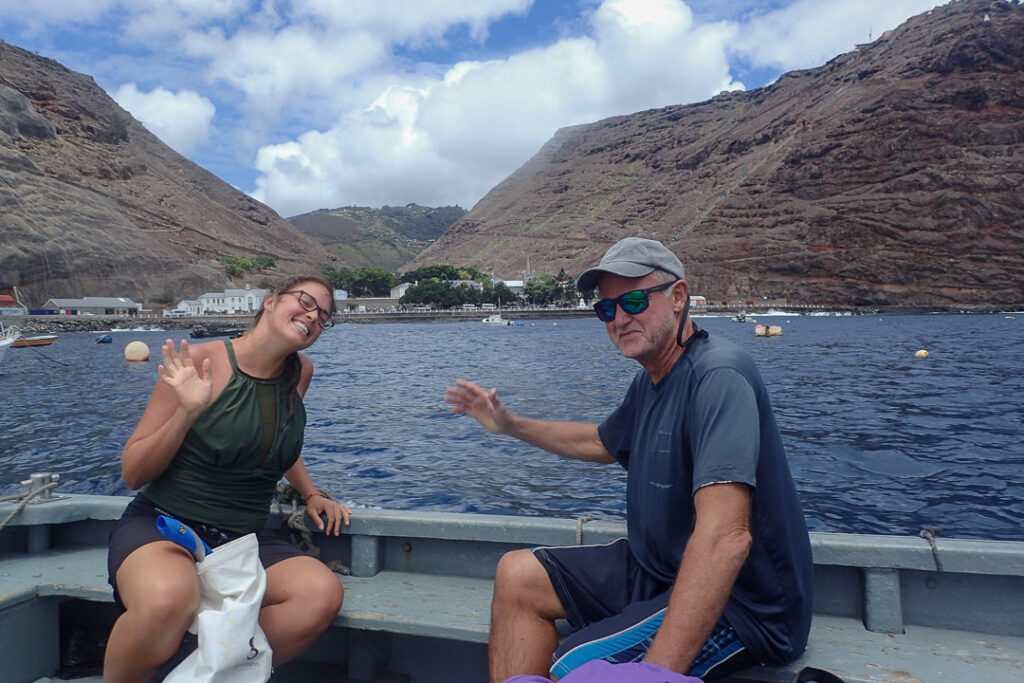
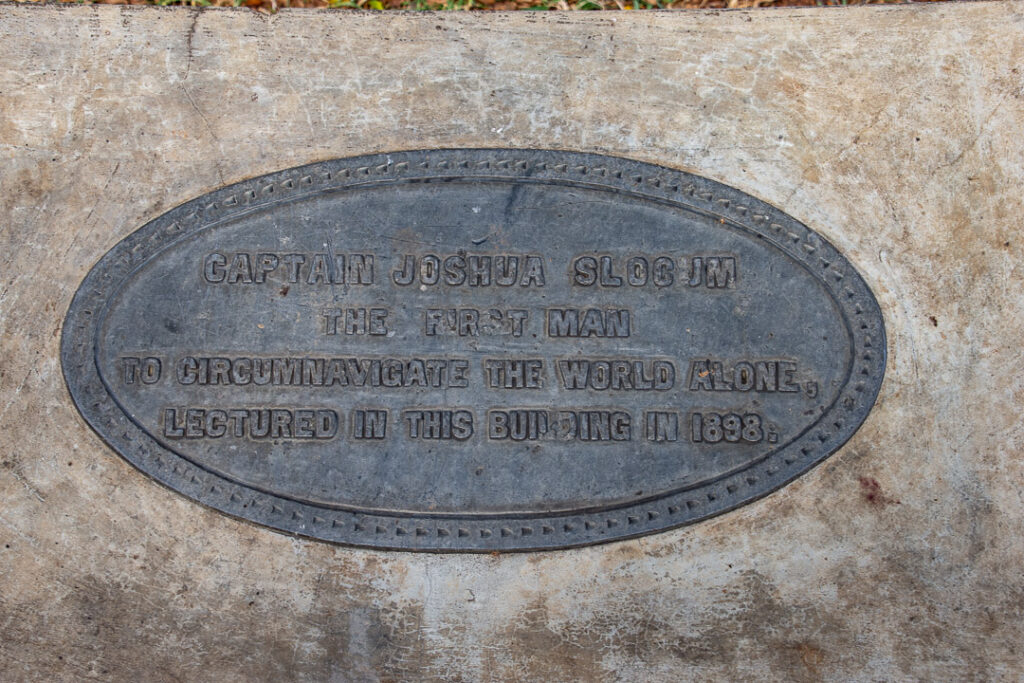
10 Comments
Amanda
May 4, 2023 - 7:16 amBeautiful photos Annie. Good luck with your next leg. What a crazy adventure. Stay well xx
annie
May 4, 2023 - 4:45 pmThanks Amanda. I’m now looking forward to getting home and back into Bristol life xx
Gerard
May 4, 2023 - 9:04 amWhat a fascinating history lesson and as usual great photos.
annie
May 4, 2023 - 4:54 pmThanks Gerard
It was a bit on the long side but such a fascinating place xx
Tom Hutchison
May 4, 2023 - 10:22 amWhat a great read Annie. loved the pictures too. One more place on earth I will never likely get to!
annie
May 4, 2023 - 4:51 pmThank you Tom. I read the Thomas Keneally book… I thought very interesting. The French Consul had met him and was rather scathing about the book. I suspect some of it was fictional… especially the racier parts.
You could incorporate a visit with a holiday in S Africa…
Annie
xx
Paul Bayley
May 5, 2023 - 7:12 amWow another great read, who would of thought you could get so much from one be it famous small island. The swimming with the shark sounded fun.
When you settle back into Bristol life you will have a lot to look back on.
Good sailing for the next leg.
Paul
annie
May 5, 2023 - 5:54 pmThank you Paul. With the voyage coming to an end I have mixed feelings. I’m looking forward to moving back into our house and will have wonderful memories. There are definitely some parts of the cruising lifestyle that I’ll miss.
xx
Carlos
May 24, 2023 - 6:20 pmGetting closer to the Americas, hoping to have you both here one of these days. We hope all is well with you guys, say hello to Hugh
annie
June 8, 2023 - 11:14 amHi Carlos
We’d love to make it stateside one day and hope to see you again in Bristol too.
Love to you all, Annie. xx